:max_bytes(150000):strip_icc():format(webp)/samsung-un65nu7100fxza-aaa-5b3bf3f1c9e77c00370afe54.jpg)
Updated Resize Like a Pro Tips for Converting Horizontal Videos to Vertical

Resize Like a Pro: Tips for Converting Horizontal Videos to Vertical
Your Number 1 Tip to Resize social media Vertical Video Ratio
An easy yet powerful editor
Numerous effects to choose from
Detailed tutorials provided by the official channel
With more and more content being designed for phones, vertical videos are widely used now.

If you too have recorded videos for posting on your social media sites, resize them in vertical video ratio and to get the right size, take help of a video ratio calculator.
In this article
01 [Benefits of Square and Vertical Videos](#Part 1)
02 [How Vertical Videos Are Displayed](#Part 2)
03 [What’s the Best Tip to Resize Social Media Vertical Video Ratio?](#Part 3)
Part 1 Benefits of Square and Vertical Videos
● What is Square Video & Vertical Video?
A Square Video is the one that has the same width and height while a vertical video is taller than it is wide. A vertical video or a square video is presented in the form of a landscape. A square video has an aspect ratio of 1:1 while a vertical video has an aspect ratio of 9:16.So, in a vertical video, the horizontal video size is less than its vertical size.
● Why Vertical Video is Dominating
It would not be wrong to say that the world has taken a mobile route and with this, the dominance of vertical videos can be seen. As per the studies it has been found that around 75% of the video playback across the globe are from mobile phones and around 94% of the time, the phones are held vertically. These figures completely state the need for the hour-vertical videos.
With users holding their mobile phones vertically the majority of the time, the dominance of the vertical videos is no surprise.
● Benefits of Square and Vertical Videos
There are several benefits of having square and vertical videos. These videos are specifically
designed for mobile phones and thus they can be easily posted on multiple social media sites without any need for change or editing. Other benefits of using vertical videos are their ease of recording through a mobile phone. Vertical videos are beneficial even for the advertisers and promoters as they help them reach more audiences and prospective customers through social media sites and other sites.
Part 2 How Vertical Videos Are Displayed
Vertical videos are majorly displayed on mobile devices as smartphones are used vertically most of the time. The width of these videos is less as compared to their height and this makes them appear fit on the smartphone’s screen. Moreover, using the screen aspect ratio calculator, you can further decide upon the aspect ratio depending on the size of the device screen on which video has to be played.
Part 3 What’s the Best Tip to Resize social media Vertical Video Ratio?
Listed below are the tips for resizing the social media vertical video ratio.
● Learn about the Aspect Ratios
A vertical video is taller than it is wide. Thus, any video that is taller than the 1:1 aspect ratio will be termed a vertical video. The commonly used aspect ratio is 9:16 that uses the complete vertical screen. So, to capture a vertical video, use the camera in portrait mode or edit it as per the vertical aspect ratio. There are also TV aspect ratio calculator tools that can be used for the task.

● Screen splitting
Multiple clips that are horizontal can be placed at the top of each other for a vertical frame as it is tall. The stacking can be done for the related clips or to make them appear as one. Place the clips creatively using patterns or lines.

● Filling the vertical space
If needed, you can creatively fill the vertical space when the shot is not a close one. One of the ideas is by raising the camera of your phone high and then moving it down that will give a deep frame. You can also fill up the vertical space below.

● Side-to-side fast movements must be avoided
Since the width area in the vertical videos is less, it is also better to avoid the fast side-to-side movement as it will create a shaky and blurry effect.

● Make use of text and graphics
To complement videos, using text and graphics is a good option. Use the vertical space smartly and include text, stickers, graphics, and other content for enhancing the video and its meaning.

● Grab attention
It is important for the videos on the social media sites to instantly catch the attention of the viewers, else they will move on to the next one. So, ensure that your vertical videos are eye-catchy and interesting with bright colors, looping animations, GIFs, and other content that is likely to hook up the viewers.

● Rule of Thirds
As per the photography rule of thirds, the main subject is not to be placed at the center and instead it the entire frame is divided into thirds using imaginary horizontal and vertical lines. The subject should be placed on these lines or where the lines meet. Use the guide grid on your phone’s camera to use this rule.

● Using a professional video editing software
If you have a video that is already recorded, you can enhance its looks and appearance using good video editing software and one such recommended tool is Wondershare Filmora Video Editor . The software is compatible with Windows and Mac and allows you to create stunning videos in just a few clicks that can be posted on several social media sites.

Wondershare Filmora - Best Video Editor for Mac/Windows
5,481,435 people have downloaded it.
Build unique custom animations without breaking a sweat.
Focus on creating epic stories and leave the details to Filmora’s auto features.
Start a creative adventure with drag & drop effects and endless possibilities.
Filmora simplifies advanced features to save you time and effort.
Filmora cuts out repetition so you can move on to your next creative breakthrough.
Using this versatile software you can add animations, motion tracking, zooming function, masking, text, and titles. Features like auto-correction, control settings, color wheels, noise reduction, audio sync, audio compression, and others are also supported.

Key Takeaways from This Episode
● With the majority of the video content being viewed on mobile phones, vertical videos have dominated the market.
● Vertical videos can be easily posted on several social media sites and other platforms without any tweaking from your phone.
● Several tips will help you to create a good vertical video for social media and using professional software like Wondershare Filmora is one of them.
With more and more content being designed for phones, vertical videos are widely used now.

If you too have recorded videos for posting on your social media sites, resize them in vertical video ratio and to get the right size, take help of a video ratio calculator.
In this article
01 [Benefits of Square and Vertical Videos](#Part 1)
02 [How Vertical Videos Are Displayed](#Part 2)
03 [What’s the Best Tip to Resize Social Media Vertical Video Ratio?](#Part 3)
Part 1 Benefits of Square and Vertical Videos
● What is Square Video & Vertical Video?
A Square Video is the one that has the same width and height while a vertical video is taller than it is wide. A vertical video or a square video is presented in the form of a landscape. A square video has an aspect ratio of 1:1 while a vertical video has an aspect ratio of 9:16.So, in a vertical video, the horizontal video size is less than its vertical size.
● Why Vertical Video is Dominating
It would not be wrong to say that the world has taken a mobile route and with this, the dominance of vertical videos can be seen. As per the studies it has been found that around 75% of the video playback across the globe are from mobile phones and around 94% of the time, the phones are held vertically. These figures completely state the need for the hour-vertical videos.
With users holding their mobile phones vertically the majority of the time, the dominance of the vertical videos is no surprise.
● Benefits of Square and Vertical Videos
There are several benefits of having square and vertical videos. These videos are specifically
designed for mobile phones and thus they can be easily posted on multiple social media sites without any need for change or editing. Other benefits of using vertical videos are their ease of recording through a mobile phone. Vertical videos are beneficial even for the advertisers and promoters as they help them reach more audiences and prospective customers through social media sites and other sites.
Part 2 How Vertical Videos Are Displayed
Vertical videos are majorly displayed on mobile devices as smartphones are used vertically most of the time. The width of these videos is less as compared to their height and this makes them appear fit on the smartphone’s screen. Moreover, using the screen aspect ratio calculator, you can further decide upon the aspect ratio depending on the size of the device screen on which video has to be played.
Part 3 What’s the Best Tip to Resize social media Vertical Video Ratio?
Listed below are the tips for resizing the social media vertical video ratio.
● Learn about the Aspect Ratios
A vertical video is taller than it is wide. Thus, any video that is taller than the 1:1 aspect ratio will be termed a vertical video. The commonly used aspect ratio is 9:16 that uses the complete vertical screen. So, to capture a vertical video, use the camera in portrait mode or edit it as per the vertical aspect ratio. There are also TV aspect ratio calculator tools that can be used for the task.

● Screen splitting
Multiple clips that are horizontal can be placed at the top of each other for a vertical frame as it is tall. The stacking can be done for the related clips or to make them appear as one. Place the clips creatively using patterns or lines.

● Filling the vertical space
If needed, you can creatively fill the vertical space when the shot is not a close one. One of the ideas is by raising the camera of your phone high and then moving it down that will give a deep frame. You can also fill up the vertical space below.

● Side-to-side fast movements must be avoided
Since the width area in the vertical videos is less, it is also better to avoid the fast side-to-side movement as it will create a shaky and blurry effect.

● Make use of text and graphics
To complement videos, using text and graphics is a good option. Use the vertical space smartly and include text, stickers, graphics, and other content for enhancing the video and its meaning.

● Grab attention
It is important for the videos on the social media sites to instantly catch the attention of the viewers, else they will move on to the next one. So, ensure that your vertical videos are eye-catchy and interesting with bright colors, looping animations, GIFs, and other content that is likely to hook up the viewers.

● Rule of Thirds
As per the photography rule of thirds, the main subject is not to be placed at the center and instead it the entire frame is divided into thirds using imaginary horizontal and vertical lines. The subject should be placed on these lines or where the lines meet. Use the guide grid on your phone’s camera to use this rule.

● Using a professional video editing software
If you have a video that is already recorded, you can enhance its looks and appearance using good video editing software and one such recommended tool is Wondershare Filmora Video Editor . The software is compatible with Windows and Mac and allows you to create stunning videos in just a few clicks that can be posted on several social media sites.

Wondershare Filmora - Best Video Editor for Mac/Windows
5,481,435 people have downloaded it.
Build unique custom animations without breaking a sweat.
Focus on creating epic stories and leave the details to Filmora’s auto features.
Start a creative adventure with drag & drop effects and endless possibilities.
Filmora simplifies advanced features to save you time and effort.
Filmora cuts out repetition so you can move on to your next creative breakthrough.
Using this versatile software you can add animations, motion tracking, zooming function, masking, text, and titles. Features like auto-correction, control settings, color wheels, noise reduction, audio sync, audio compression, and others are also supported.

Key Takeaways from This Episode
● With the majority of the video content being viewed on mobile phones, vertical videos have dominated the market.
● Vertical videos can be easily posted on several social media sites and other platforms without any tweaking from your phone.
● Several tips will help you to create a good vertical video for social media and using professional software like Wondershare Filmora is one of them.
With more and more content being designed for phones, vertical videos are widely used now.

If you too have recorded videos for posting on your social media sites, resize them in vertical video ratio and to get the right size, take help of a video ratio calculator.
In this article
01 [Benefits of Square and Vertical Videos](#Part 1)
02 [How Vertical Videos Are Displayed](#Part 2)
03 [What’s the Best Tip to Resize Social Media Vertical Video Ratio?](#Part 3)
Part 1 Benefits of Square and Vertical Videos
● What is Square Video & Vertical Video?
A Square Video is the one that has the same width and height while a vertical video is taller than it is wide. A vertical video or a square video is presented in the form of a landscape. A square video has an aspect ratio of 1:1 while a vertical video has an aspect ratio of 9:16.So, in a vertical video, the horizontal video size is less than its vertical size.
● Why Vertical Video is Dominating
It would not be wrong to say that the world has taken a mobile route and with this, the dominance of vertical videos can be seen. As per the studies it has been found that around 75% of the video playback across the globe are from mobile phones and around 94% of the time, the phones are held vertically. These figures completely state the need for the hour-vertical videos.
With users holding their mobile phones vertically the majority of the time, the dominance of the vertical videos is no surprise.
● Benefits of Square and Vertical Videos
There are several benefits of having square and vertical videos. These videos are specifically
designed for mobile phones and thus they can be easily posted on multiple social media sites without any need for change or editing. Other benefits of using vertical videos are their ease of recording through a mobile phone. Vertical videos are beneficial even for the advertisers and promoters as they help them reach more audiences and prospective customers through social media sites and other sites.
Part 2 How Vertical Videos Are Displayed
Vertical videos are majorly displayed on mobile devices as smartphones are used vertically most of the time. The width of these videos is less as compared to their height and this makes them appear fit on the smartphone’s screen. Moreover, using the screen aspect ratio calculator, you can further decide upon the aspect ratio depending on the size of the device screen on which video has to be played.
Part 3 What’s the Best Tip to Resize social media Vertical Video Ratio?
Listed below are the tips for resizing the social media vertical video ratio.
● Learn about the Aspect Ratios
A vertical video is taller than it is wide. Thus, any video that is taller than the 1:1 aspect ratio will be termed a vertical video. The commonly used aspect ratio is 9:16 that uses the complete vertical screen. So, to capture a vertical video, use the camera in portrait mode or edit it as per the vertical aspect ratio. There are also TV aspect ratio calculator tools that can be used for the task.

● Screen splitting
Multiple clips that are horizontal can be placed at the top of each other for a vertical frame as it is tall. The stacking can be done for the related clips or to make them appear as one. Place the clips creatively using patterns or lines.

● Filling the vertical space
If needed, you can creatively fill the vertical space when the shot is not a close one. One of the ideas is by raising the camera of your phone high and then moving it down that will give a deep frame. You can also fill up the vertical space below.

● Side-to-side fast movements must be avoided
Since the width area in the vertical videos is less, it is also better to avoid the fast side-to-side movement as it will create a shaky and blurry effect.

● Make use of text and graphics
To complement videos, using text and graphics is a good option. Use the vertical space smartly and include text, stickers, graphics, and other content for enhancing the video and its meaning.

● Grab attention
It is important for the videos on the social media sites to instantly catch the attention of the viewers, else they will move on to the next one. So, ensure that your vertical videos are eye-catchy and interesting with bright colors, looping animations, GIFs, and other content that is likely to hook up the viewers.

● Rule of Thirds
As per the photography rule of thirds, the main subject is not to be placed at the center and instead it the entire frame is divided into thirds using imaginary horizontal and vertical lines. The subject should be placed on these lines or where the lines meet. Use the guide grid on your phone’s camera to use this rule.

● Using a professional video editing software
If you have a video that is already recorded, you can enhance its looks and appearance using good video editing software and one such recommended tool is Wondershare Filmora Video Editor . The software is compatible with Windows and Mac and allows you to create stunning videos in just a few clicks that can be posted on several social media sites.

Wondershare Filmora - Best Video Editor for Mac/Windows
5,481,435 people have downloaded it.
Build unique custom animations without breaking a sweat.
Focus on creating epic stories and leave the details to Filmora’s auto features.
Start a creative adventure with drag & drop effects and endless possibilities.
Filmora simplifies advanced features to save you time and effort.
Filmora cuts out repetition so you can move on to your next creative breakthrough.
Using this versatile software you can add animations, motion tracking, zooming function, masking, text, and titles. Features like auto-correction, control settings, color wheels, noise reduction, audio sync, audio compression, and others are also supported.

Key Takeaways from This Episode
● With the majority of the video content being viewed on mobile phones, vertical videos have dominated the market.
● Vertical videos can be easily posted on several social media sites and other platforms without any tweaking from your phone.
● Several tips will help you to create a good vertical video for social media and using professional software like Wondershare Filmora is one of them.
With more and more content being designed for phones, vertical videos are widely used now.

If you too have recorded videos for posting on your social media sites, resize them in vertical video ratio and to get the right size, take help of a video ratio calculator.
In this article
01 [Benefits of Square and Vertical Videos](#Part 1)
02 [How Vertical Videos Are Displayed](#Part 2)
03 [What’s the Best Tip to Resize Social Media Vertical Video Ratio?](#Part 3)
Part 1 Benefits of Square and Vertical Videos
● What is Square Video & Vertical Video?
A Square Video is the one that has the same width and height while a vertical video is taller than it is wide. A vertical video or a square video is presented in the form of a landscape. A square video has an aspect ratio of 1:1 while a vertical video has an aspect ratio of 9:16.So, in a vertical video, the horizontal video size is less than its vertical size.
● Why Vertical Video is Dominating
It would not be wrong to say that the world has taken a mobile route and with this, the dominance of vertical videos can be seen. As per the studies it has been found that around 75% of the video playback across the globe are from mobile phones and around 94% of the time, the phones are held vertically. These figures completely state the need for the hour-vertical videos.
With users holding their mobile phones vertically the majority of the time, the dominance of the vertical videos is no surprise.
● Benefits of Square and Vertical Videos
There are several benefits of having square and vertical videos. These videos are specifically
designed for mobile phones and thus they can be easily posted on multiple social media sites without any need for change or editing. Other benefits of using vertical videos are their ease of recording through a mobile phone. Vertical videos are beneficial even for the advertisers and promoters as they help them reach more audiences and prospective customers through social media sites and other sites.
Part 2 How Vertical Videos Are Displayed
Vertical videos are majorly displayed on mobile devices as smartphones are used vertically most of the time. The width of these videos is less as compared to their height and this makes them appear fit on the smartphone’s screen. Moreover, using the screen aspect ratio calculator, you can further decide upon the aspect ratio depending on the size of the device screen on which video has to be played.
Part 3 What’s the Best Tip to Resize social media Vertical Video Ratio?
Listed below are the tips for resizing the social media vertical video ratio.
● Learn about the Aspect Ratios
A vertical video is taller than it is wide. Thus, any video that is taller than the 1:1 aspect ratio will be termed a vertical video. The commonly used aspect ratio is 9:16 that uses the complete vertical screen. So, to capture a vertical video, use the camera in portrait mode or edit it as per the vertical aspect ratio. There are also TV aspect ratio calculator tools that can be used for the task.

● Screen splitting
Multiple clips that are horizontal can be placed at the top of each other for a vertical frame as it is tall. The stacking can be done for the related clips or to make them appear as one. Place the clips creatively using patterns or lines.

● Filling the vertical space
If needed, you can creatively fill the vertical space when the shot is not a close one. One of the ideas is by raising the camera of your phone high and then moving it down that will give a deep frame. You can also fill up the vertical space below.

● Side-to-side fast movements must be avoided
Since the width area in the vertical videos is less, it is also better to avoid the fast side-to-side movement as it will create a shaky and blurry effect.

● Make use of text and graphics
To complement videos, using text and graphics is a good option. Use the vertical space smartly and include text, stickers, graphics, and other content for enhancing the video and its meaning.

● Grab attention
It is important for the videos on the social media sites to instantly catch the attention of the viewers, else they will move on to the next one. So, ensure that your vertical videos are eye-catchy and interesting with bright colors, looping animations, GIFs, and other content that is likely to hook up the viewers.

● Rule of Thirds
As per the photography rule of thirds, the main subject is not to be placed at the center and instead it the entire frame is divided into thirds using imaginary horizontal and vertical lines. The subject should be placed on these lines or where the lines meet. Use the guide grid on your phone’s camera to use this rule.

● Using a professional video editing software
If you have a video that is already recorded, you can enhance its looks and appearance using good video editing software and one such recommended tool is Wondershare Filmora Video Editor . The software is compatible with Windows and Mac and allows you to create stunning videos in just a few clicks that can be posted on several social media sites.

Wondershare Filmora - Best Video Editor for Mac/Windows
5,481,435 people have downloaded it.
Build unique custom animations without breaking a sweat.
Focus on creating epic stories and leave the details to Filmora’s auto features.
Start a creative adventure with drag & drop effects and endless possibilities.
Filmora simplifies advanced features to save you time and effort.
Filmora cuts out repetition so you can move on to your next creative breakthrough.
Using this versatile software you can add animations, motion tracking, zooming function, masking, text, and titles. Features like auto-correction, control settings, color wheels, noise reduction, audio sync, audio compression, and others are also supported.

Key Takeaways from This Episode
● With the majority of the video content being viewed on mobile phones, vertical videos have dominated the market.
● Vertical videos can be easily posted on several social media sites and other platforms without any tweaking from your phone.
● Several tips will help you to create a good vertical video for social media and using professional software like Wondershare Filmora is one of them.
Mastering Audio Transitions: 2 Methods in Final Cut Pro
Two Ways to Fade In/Out Audio in Final Cut Pro

Benjamin Arango
Mar 27, 2024• Proven solutions
Creating a fade in or out effect in Final Cut Pro will make your audio amazing. However, as Final Cut Pro is for pros, not every user knows how to make fade in/out audio. In fact, it is very easy to fade audio in Final Cut Pro. This tutorial will show you how to apply effects like fade-in, fade-out, and crossfade to your audio clips using Final Cut Pro in two ways.
Part 1: Use the Modify Menu to Fade In/Out Audio
Part 2: Use Fade Handles to Fade In/Out Audio
This tutorial offers only the basics of the audio fading techniques in Apple Final Cut Pro X, which is a specialized video editing software used by professionals worldwide. If you are an amateur who is new to video editing, we suggest you begin with Wondershare Filmora for Mac (originally Wondershare Video Editor for Mac). It is a powerful yet easy-to-use software that is ideal for beginners. You can download the free trial version of Wondershare Filmora below.
 Download Mac Version ](https://tools.techidaily.com/wondershare/filmora/download/ )
Download Mac Version ](https://tools.techidaily.com/wondershare/filmora/download/ )
With this modern and extremely user-friendly tool, you’ll find that applying effects like fade-in, fade-out, or crossfade to your audio clips is very easy.
Before we get started, you can firstly detach the audio from video to better edit it. Locate your audio clip in the timeline, highlight the desired audio/video clip, right click on it, and choose Detach audio to unlink your audio from your video to edit them as separate elements.
Check more articles here, if you are also interested in other audio editing tips in Final Cut Pro or want to know how to record a voice over with FCP.
Part 1: How to Fade Audio by using the Modify Menu
You can go to the Modify menu and easily apply fade-in or fade-outs to the audio clip you are editing. The Final Cut Pro preferences also allow you to adjust the fade duration.
Step 1 : First, you have to select the audio or the video clips with audio in the timeline.

Step 2 : Select Modify> Adjust Volume> Apply Fades.

You should remember that the fades appear at the beginning and the end of each clip. The default duration of the fade is one half-second. If you want to modify that duration, you just have to drag the fade handle up to the point where your fade is supposed to begin or end.

Step 3: If you want to remove the fades, choose Modify > Adjust Volume > Remove Fades.
See more details on how to fade audio in Final Cut Pro from the following video.
Part 2: How to Fade Music by using Fade Handles
You have already learned how to find the fade handles on the screen. Now, you just have to manually drag the handle to the exact point from which you want the fade to begin or end. Just keep in mid this simple rule: fade handles at the beginning of a clip produce fade-in effects, whereas fade handles at the end give fade-out effects.
You can manually fade-in or out a portion of the audio clip on your timeline by using the fade handles. Place the pointer over the clip and you can see the fade handles appearing in the top left and right corners of the waveform. To change the sound of the fade, you’ll have to modify the shape of the fade by selecting one of the several preconfigured choices.
Using the fade handles to create crossfades:
Step 1 : To create a crossfade, first you have to select two adjacent clips in the timeline. After that choose Clip> Expand Audio (or press Control-S). You can see the waveforms on your screen expanding.
Step 2 : To overlap the audio parts of the two clips on your timeline, just drag the end point of the first clip and the start point of the second clip.
Step 3 : Now, you’ll have to drag the fade handles of each clip to the exact points where you want the fade to start and finish.

Tips: How to change fade shapes while using the fade handle
You can easily change the sound of your fades by modifying the default fade shape. For this, you’ll have to control-click a fade handle and select one of the fade preferences from the list.

- Linear: The rate of change is constant over the length of the fade.
- S-curve: Eases in and out of the fade with the midpoint at 0 dB.
- +3dB: Picks up quickly and then gradually peters out toward the end. This is the considered to be the most useful mode while choosing a quick fade.
- –3dB: Begins slowly and then toward the end picks up fast. This setting allows you to maintain a perfectly natural volume while crossfading two clips.
- Linear: Maintains a constant rate of change over the length of the fade.
- S-curve: Eases in and out of the fade with the midpoint at 0 dB.
- +3dB: Starts quickly and then slowly tapers off toward the end. This is the most useful setting for quick fades.
- –3dB: Starts slowly and then moves quickly toward the end. This is the default setting and is best for maintaining a natural volume when crossfading between two adjacent clips.

Benjamin Arango
Benjamin Arango is a writer and a lover of all things video.
Follow @Benjamin Arango
Benjamin Arango
Mar 27, 2024• Proven solutions
Creating a fade in or out effect in Final Cut Pro will make your audio amazing. However, as Final Cut Pro is for pros, not every user knows how to make fade in/out audio. In fact, it is very easy to fade audio in Final Cut Pro. This tutorial will show you how to apply effects like fade-in, fade-out, and crossfade to your audio clips using Final Cut Pro in two ways.
Part 1: Use the Modify Menu to Fade In/Out Audio
Part 2: Use Fade Handles to Fade In/Out Audio
This tutorial offers only the basics of the audio fading techniques in Apple Final Cut Pro X, which is a specialized video editing software used by professionals worldwide. If you are an amateur who is new to video editing, we suggest you begin with Wondershare Filmora for Mac (originally Wondershare Video Editor for Mac). It is a powerful yet easy-to-use software that is ideal for beginners. You can download the free trial version of Wondershare Filmora below.
 Download Mac Version ](https://tools.techidaily.com/wondershare/filmora/download/ )
Download Mac Version ](https://tools.techidaily.com/wondershare/filmora/download/ )
With this modern and extremely user-friendly tool, you’ll find that applying effects like fade-in, fade-out, or crossfade to your audio clips is very easy.
Before we get started, you can firstly detach the audio from video to better edit it. Locate your audio clip in the timeline, highlight the desired audio/video clip, right click on it, and choose Detach audio to unlink your audio from your video to edit them as separate elements.
Check more articles here, if you are also interested in other audio editing tips in Final Cut Pro or want to know how to record a voice over with FCP.
Part 1: How to Fade Audio by using the Modify Menu
You can go to the Modify menu and easily apply fade-in or fade-outs to the audio clip you are editing. The Final Cut Pro preferences also allow you to adjust the fade duration.
Step 1 : First, you have to select the audio or the video clips with audio in the timeline.

Step 2 : Select Modify> Adjust Volume> Apply Fades.

You should remember that the fades appear at the beginning and the end of each clip. The default duration of the fade is one half-second. If you want to modify that duration, you just have to drag the fade handle up to the point where your fade is supposed to begin or end.

Step 3: If you want to remove the fades, choose Modify > Adjust Volume > Remove Fades.
See more details on how to fade audio in Final Cut Pro from the following video.
Part 2: How to Fade Music by using Fade Handles
You have already learned how to find the fade handles on the screen. Now, you just have to manually drag the handle to the exact point from which you want the fade to begin or end. Just keep in mid this simple rule: fade handles at the beginning of a clip produce fade-in effects, whereas fade handles at the end give fade-out effects.
You can manually fade-in or out a portion of the audio clip on your timeline by using the fade handles. Place the pointer over the clip and you can see the fade handles appearing in the top left and right corners of the waveform. To change the sound of the fade, you’ll have to modify the shape of the fade by selecting one of the several preconfigured choices.
Using the fade handles to create crossfades:
Step 1 : To create a crossfade, first you have to select two adjacent clips in the timeline. After that choose Clip> Expand Audio (or press Control-S). You can see the waveforms on your screen expanding.
Step 2 : To overlap the audio parts of the two clips on your timeline, just drag the end point of the first clip and the start point of the second clip.
Step 3 : Now, you’ll have to drag the fade handles of each clip to the exact points where you want the fade to start and finish.

Tips: How to change fade shapes while using the fade handle
You can easily change the sound of your fades by modifying the default fade shape. For this, you’ll have to control-click a fade handle and select one of the fade preferences from the list.

- Linear: The rate of change is constant over the length of the fade.
- S-curve: Eases in and out of the fade with the midpoint at 0 dB.
- +3dB: Picks up quickly and then gradually peters out toward the end. This is the considered to be the most useful mode while choosing a quick fade.
- –3dB: Begins slowly and then toward the end picks up fast. This setting allows you to maintain a perfectly natural volume while crossfading two clips.
- Linear: Maintains a constant rate of change over the length of the fade.
- S-curve: Eases in and out of the fade with the midpoint at 0 dB.
- +3dB: Starts quickly and then slowly tapers off toward the end. This is the most useful setting for quick fades.
- –3dB: Starts slowly and then moves quickly toward the end. This is the default setting and is best for maintaining a natural volume when crossfading between two adjacent clips.

Benjamin Arango
Benjamin Arango is a writer and a lover of all things video.
Follow @Benjamin Arango
Benjamin Arango
Mar 27, 2024• Proven solutions
Creating a fade in or out effect in Final Cut Pro will make your audio amazing. However, as Final Cut Pro is for pros, not every user knows how to make fade in/out audio. In fact, it is very easy to fade audio in Final Cut Pro. This tutorial will show you how to apply effects like fade-in, fade-out, and crossfade to your audio clips using Final Cut Pro in two ways.
Part 1: Use the Modify Menu to Fade In/Out Audio
Part 2: Use Fade Handles to Fade In/Out Audio
This tutorial offers only the basics of the audio fading techniques in Apple Final Cut Pro X, which is a specialized video editing software used by professionals worldwide. If you are an amateur who is new to video editing, we suggest you begin with Wondershare Filmora for Mac (originally Wondershare Video Editor for Mac). It is a powerful yet easy-to-use software that is ideal for beginners. You can download the free trial version of Wondershare Filmora below.
 Download Mac Version ](https://tools.techidaily.com/wondershare/filmora/download/ )
Download Mac Version ](https://tools.techidaily.com/wondershare/filmora/download/ )
With this modern and extremely user-friendly tool, you’ll find that applying effects like fade-in, fade-out, or crossfade to your audio clips is very easy.
Before we get started, you can firstly detach the audio from video to better edit it. Locate your audio clip in the timeline, highlight the desired audio/video clip, right click on it, and choose Detach audio to unlink your audio from your video to edit them as separate elements.
Check more articles here, if you are also interested in other audio editing tips in Final Cut Pro or want to know how to record a voice over with FCP.
Part 1: How to Fade Audio by using the Modify Menu
You can go to the Modify menu and easily apply fade-in or fade-outs to the audio clip you are editing. The Final Cut Pro preferences also allow you to adjust the fade duration.
Step 1 : First, you have to select the audio or the video clips with audio in the timeline.

Step 2 : Select Modify> Adjust Volume> Apply Fades.

You should remember that the fades appear at the beginning and the end of each clip. The default duration of the fade is one half-second. If you want to modify that duration, you just have to drag the fade handle up to the point where your fade is supposed to begin or end.

Step 3: If you want to remove the fades, choose Modify > Adjust Volume > Remove Fades.
See more details on how to fade audio in Final Cut Pro from the following video.
Part 2: How to Fade Music by using Fade Handles
You have already learned how to find the fade handles on the screen. Now, you just have to manually drag the handle to the exact point from which you want the fade to begin or end. Just keep in mid this simple rule: fade handles at the beginning of a clip produce fade-in effects, whereas fade handles at the end give fade-out effects.
You can manually fade-in or out a portion of the audio clip on your timeline by using the fade handles. Place the pointer over the clip and you can see the fade handles appearing in the top left and right corners of the waveform. To change the sound of the fade, you’ll have to modify the shape of the fade by selecting one of the several preconfigured choices.
Using the fade handles to create crossfades:
Step 1 : To create a crossfade, first you have to select two adjacent clips in the timeline. After that choose Clip> Expand Audio (or press Control-S). You can see the waveforms on your screen expanding.
Step 2 : To overlap the audio parts of the two clips on your timeline, just drag the end point of the first clip and the start point of the second clip.
Step 3 : Now, you’ll have to drag the fade handles of each clip to the exact points where you want the fade to start and finish.

Tips: How to change fade shapes while using the fade handle
You can easily change the sound of your fades by modifying the default fade shape. For this, you’ll have to control-click a fade handle and select one of the fade preferences from the list.

- Linear: The rate of change is constant over the length of the fade.
- S-curve: Eases in and out of the fade with the midpoint at 0 dB.
- +3dB: Picks up quickly and then gradually peters out toward the end. This is the considered to be the most useful mode while choosing a quick fade.
- –3dB: Begins slowly and then toward the end picks up fast. This setting allows you to maintain a perfectly natural volume while crossfading two clips.
- Linear: Maintains a constant rate of change over the length of the fade.
- S-curve: Eases in and out of the fade with the midpoint at 0 dB.
- +3dB: Starts quickly and then slowly tapers off toward the end. This is the most useful setting for quick fades.
- –3dB: Starts slowly and then moves quickly toward the end. This is the default setting and is best for maintaining a natural volume when crossfading between two adjacent clips.

Benjamin Arango
Benjamin Arango is a writer and a lover of all things video.
Follow @Benjamin Arango
Benjamin Arango
Mar 27, 2024• Proven solutions
Creating a fade in or out effect in Final Cut Pro will make your audio amazing. However, as Final Cut Pro is for pros, not every user knows how to make fade in/out audio. In fact, it is very easy to fade audio in Final Cut Pro. This tutorial will show you how to apply effects like fade-in, fade-out, and crossfade to your audio clips using Final Cut Pro in two ways.
Part 1: Use the Modify Menu to Fade In/Out Audio
Part 2: Use Fade Handles to Fade In/Out Audio
This tutorial offers only the basics of the audio fading techniques in Apple Final Cut Pro X, which is a specialized video editing software used by professionals worldwide. If you are an amateur who is new to video editing, we suggest you begin with Wondershare Filmora for Mac (originally Wondershare Video Editor for Mac). It is a powerful yet easy-to-use software that is ideal for beginners. You can download the free trial version of Wondershare Filmora below.
 Download Mac Version ](https://tools.techidaily.com/wondershare/filmora/download/ )
Download Mac Version ](https://tools.techidaily.com/wondershare/filmora/download/ )
With this modern and extremely user-friendly tool, you’ll find that applying effects like fade-in, fade-out, or crossfade to your audio clips is very easy.
Before we get started, you can firstly detach the audio from video to better edit it. Locate your audio clip in the timeline, highlight the desired audio/video clip, right click on it, and choose Detach audio to unlink your audio from your video to edit them as separate elements.
Check more articles here, if you are also interested in other audio editing tips in Final Cut Pro or want to know how to record a voice over with FCP.
Part 1: How to Fade Audio by using the Modify Menu
You can go to the Modify menu and easily apply fade-in or fade-outs to the audio clip you are editing. The Final Cut Pro preferences also allow you to adjust the fade duration.
Step 1 : First, you have to select the audio or the video clips with audio in the timeline.

Step 2 : Select Modify> Adjust Volume> Apply Fades.

You should remember that the fades appear at the beginning and the end of each clip. The default duration of the fade is one half-second. If you want to modify that duration, you just have to drag the fade handle up to the point where your fade is supposed to begin or end.

Step 3: If you want to remove the fades, choose Modify > Adjust Volume > Remove Fades.
See more details on how to fade audio in Final Cut Pro from the following video.
Part 2: How to Fade Music by using Fade Handles
You have already learned how to find the fade handles on the screen. Now, you just have to manually drag the handle to the exact point from which you want the fade to begin or end. Just keep in mid this simple rule: fade handles at the beginning of a clip produce fade-in effects, whereas fade handles at the end give fade-out effects.
You can manually fade-in or out a portion of the audio clip on your timeline by using the fade handles. Place the pointer over the clip and you can see the fade handles appearing in the top left and right corners of the waveform. To change the sound of the fade, you’ll have to modify the shape of the fade by selecting one of the several preconfigured choices.
Using the fade handles to create crossfades:
Step 1 : To create a crossfade, first you have to select two adjacent clips in the timeline. After that choose Clip> Expand Audio (or press Control-S). You can see the waveforms on your screen expanding.
Step 2 : To overlap the audio parts of the two clips on your timeline, just drag the end point of the first clip and the start point of the second clip.
Step 3 : Now, you’ll have to drag the fade handles of each clip to the exact points where you want the fade to start and finish.

Tips: How to change fade shapes while using the fade handle
You can easily change the sound of your fades by modifying the default fade shape. For this, you’ll have to control-click a fade handle and select one of the fade preferences from the list.

- Linear: The rate of change is constant over the length of the fade.
- S-curve: Eases in and out of the fade with the midpoint at 0 dB.
- +3dB: Picks up quickly and then gradually peters out toward the end. This is the considered to be the most useful mode while choosing a quick fade.
- –3dB: Begins slowly and then toward the end picks up fast. This setting allows you to maintain a perfectly natural volume while crossfading two clips.
- Linear: Maintains a constant rate of change over the length of the fade.
- S-curve: Eases in and out of the fade with the midpoint at 0 dB.
- +3dB: Starts quickly and then slowly tapers off toward the end. This is the most useful setting for quick fades.
- –3dB: Starts slowly and then moves quickly toward the end. This is the default setting and is best for maintaining a natural volume when crossfading between two adjacent clips.

Benjamin Arango
Benjamin Arango is a writer and a lover of all things video.
Follow @Benjamin Arango
The Ultimate Guide to Video Editing on Mac OS X Yosemite
How to Edit Video Files on Mac OS X Yosemite

Liza Brown
Mar 27, 2024• Proven solutions
Although Apple’s new operating system - Mac OS X 10.10 Yosemite will bring new vigor to your Mac computer, you may have to face the roadblock when it comes to video editing, since its built-in video editing software iMovie only supports a limited formats. So what would you do then? Have no direction to edit video on Mac OS X 10.10?
Don’t worry. Here a comprehensive and easy-to-use video editor for Yosemite – Wondershare Filmora for Mac is recommended. It supports almost all the popular video formats including AVI, WMV, MP4, FLV, MKV, MOV, 3GP, etc. With it, you can put together your video clips or split to segments to get creative and customized brand new videos. Here is a detailed guide on how to create videos on Yosemite with this smart video editor.
Step 1. Import media files to edit
To import videos, audio, photos to edit, you can go to “File”>”Import Media” or directly drag and drop them to the Media Library of this app. By the way, there is a window which allows you to import media files from your iTunes or iMovie etc. To activate it, just go to “File” > “Resources”. You can also capture a video with the built-in iSight by clicking the “Video Recording” icon above the timeline.
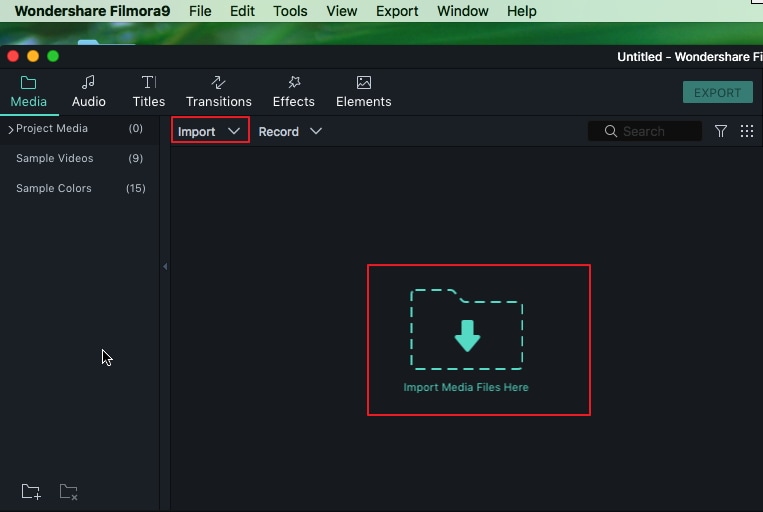
Step 2. Edit videos, audio and photos
When all the media files have been imported to the software, drag and drop them to the respective timeline. Then you can do various video editing tasks as you like.
Basic editing
You have two different ways to edit the video. One is to double click the video and then choose different editing options. The other is to hit the corresponding Trim, Crop, Rotate, Voiceover button on the tool bar.
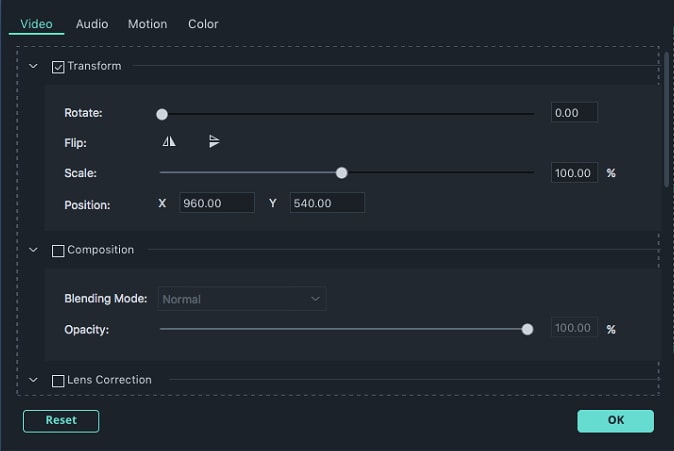
Edit and enhance audio
If you want to add an additional audio file as the background music to the videos and photos, just drag your favorite audio clip to the music track. To further edit the audio file, just double click the clip. Then the Audio Inspector will pop up for you to adjust different settings like pitch, volume, and speed or add Fade in/out effect. You can also right click the audio to cut, copy or trim the audio file.

Add transition and other effects
This app also allows you to add cool transitions and other effects to your videos and photos. To achieve this, just go to the respective tab in near the Media Library. For more details, please go to the user guide of Filmora for Mac.
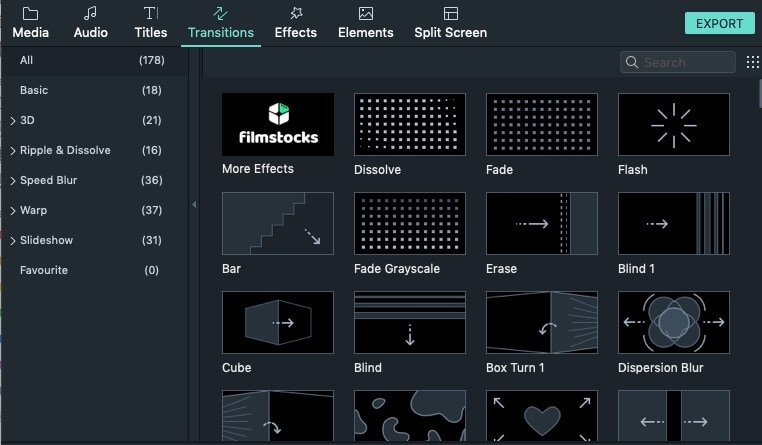
Step 3. Export your video creation
After you preview the effect, just click the “Export” button to export the video creator. There are totally five methods: Devices, Formats, YouTube, Vimeo and DVD. Just select any one you want to save or share the edited videos.


Liza Brown
Liza Brown is a writer and a lover of all things video.
Follow @Liza Brown
Liza Brown
Mar 27, 2024• Proven solutions
Although Apple’s new operating system - Mac OS X 10.10 Yosemite will bring new vigor to your Mac computer, you may have to face the roadblock when it comes to video editing, since its built-in video editing software iMovie only supports a limited formats. So what would you do then? Have no direction to edit video on Mac OS X 10.10?
Don’t worry. Here a comprehensive and easy-to-use video editor for Yosemite – Wondershare Filmora for Mac is recommended. It supports almost all the popular video formats including AVI, WMV, MP4, FLV, MKV, MOV, 3GP, etc. With it, you can put together your video clips or split to segments to get creative and customized brand new videos. Here is a detailed guide on how to create videos on Yosemite with this smart video editor.
Step 1. Import media files to edit
To import videos, audio, photos to edit, you can go to “File”>”Import Media” or directly drag and drop them to the Media Library of this app. By the way, there is a window which allows you to import media files from your iTunes or iMovie etc. To activate it, just go to “File” > “Resources”. You can also capture a video with the built-in iSight by clicking the “Video Recording” icon above the timeline.

Step 2. Edit videos, audio and photos
When all the media files have been imported to the software, drag and drop them to the respective timeline. Then you can do various video editing tasks as you like.
Basic editing
You have two different ways to edit the video. One is to double click the video and then choose different editing options. The other is to hit the corresponding Trim, Crop, Rotate, Voiceover button on the tool bar.

Edit and enhance audio
If you want to add an additional audio file as the background music to the videos and photos, just drag your favorite audio clip to the music track. To further edit the audio file, just double click the clip. Then the Audio Inspector will pop up for you to adjust different settings like pitch, volume, and speed or add Fade in/out effect. You can also right click the audio to cut, copy or trim the audio file.

Add transition and other effects
This app also allows you to add cool transitions and other effects to your videos and photos. To achieve this, just go to the respective tab in near the Media Library. For more details, please go to the user guide of Filmora for Mac.

Step 3. Export your video creation
After you preview the effect, just click the “Export” button to export the video creator. There are totally five methods: Devices, Formats, YouTube, Vimeo and DVD. Just select any one you want to save or share the edited videos.


Liza Brown
Liza Brown is a writer and a lover of all things video.
Follow @Liza Brown
Liza Brown
Mar 27, 2024• Proven solutions
Although Apple’s new operating system - Mac OS X 10.10 Yosemite will bring new vigor to your Mac computer, you may have to face the roadblock when it comes to video editing, since its built-in video editing software iMovie only supports a limited formats. So what would you do then? Have no direction to edit video on Mac OS X 10.10?
Don’t worry. Here a comprehensive and easy-to-use video editor for Yosemite – Wondershare Filmora for Mac is recommended. It supports almost all the popular video formats including AVI, WMV, MP4, FLV, MKV, MOV, 3GP, etc. With it, you can put together your video clips or split to segments to get creative and customized brand new videos. Here is a detailed guide on how to create videos on Yosemite with this smart video editor.
Step 1. Import media files to edit
To import videos, audio, photos to edit, you can go to “File”>”Import Media” or directly drag and drop them to the Media Library of this app. By the way, there is a window which allows you to import media files from your iTunes or iMovie etc. To activate it, just go to “File” > “Resources”. You can also capture a video with the built-in iSight by clicking the “Video Recording” icon above the timeline.

Step 2. Edit videos, audio and photos
When all the media files have been imported to the software, drag and drop them to the respective timeline. Then you can do various video editing tasks as you like.
Basic editing
You have two different ways to edit the video. One is to double click the video and then choose different editing options. The other is to hit the corresponding Trim, Crop, Rotate, Voiceover button on the tool bar.

Edit and enhance audio
If you want to add an additional audio file as the background music to the videos and photos, just drag your favorite audio clip to the music track. To further edit the audio file, just double click the clip. Then the Audio Inspector will pop up for you to adjust different settings like pitch, volume, and speed or add Fade in/out effect. You can also right click the audio to cut, copy or trim the audio file.

Add transition and other effects
This app also allows you to add cool transitions and other effects to your videos and photos. To achieve this, just go to the respective tab in near the Media Library. For more details, please go to the user guide of Filmora for Mac.

Step 3. Export your video creation
After you preview the effect, just click the “Export” button to export the video creator. There are totally five methods: Devices, Formats, YouTube, Vimeo and DVD. Just select any one you want to save or share the edited videos.


Liza Brown
Liza Brown is a writer and a lover of all things video.
Follow @Liza Brown
Liza Brown
Mar 27, 2024• Proven solutions
Although Apple’s new operating system - Mac OS X 10.10 Yosemite will bring new vigor to your Mac computer, you may have to face the roadblock when it comes to video editing, since its built-in video editing software iMovie only supports a limited formats. So what would you do then? Have no direction to edit video on Mac OS X 10.10?
Don’t worry. Here a comprehensive and easy-to-use video editor for Yosemite – Wondershare Filmora for Mac is recommended. It supports almost all the popular video formats including AVI, WMV, MP4, FLV, MKV, MOV, 3GP, etc. With it, you can put together your video clips or split to segments to get creative and customized brand new videos. Here is a detailed guide on how to create videos on Yosemite with this smart video editor.
Step 1. Import media files to edit
To import videos, audio, photos to edit, you can go to “File”>”Import Media” or directly drag and drop them to the Media Library of this app. By the way, there is a window which allows you to import media files from your iTunes or iMovie etc. To activate it, just go to “File” > “Resources”. You can also capture a video with the built-in iSight by clicking the “Video Recording” icon above the timeline.

Step 2. Edit videos, audio and photos
When all the media files have been imported to the software, drag and drop them to the respective timeline. Then you can do various video editing tasks as you like.
Basic editing
You have two different ways to edit the video. One is to double click the video and then choose different editing options. The other is to hit the corresponding Trim, Crop, Rotate, Voiceover button on the tool bar.

Edit and enhance audio
If you want to add an additional audio file as the background music to the videos and photos, just drag your favorite audio clip to the music track. To further edit the audio file, just double click the clip. Then the Audio Inspector will pop up for you to adjust different settings like pitch, volume, and speed or add Fade in/out effect. You can also right click the audio to cut, copy or trim the audio file.

Add transition and other effects
This app also allows you to add cool transitions and other effects to your videos and photos. To achieve this, just go to the respective tab in near the Media Library. For more details, please go to the user guide of Filmora for Mac.

Step 3. Export your video creation
After you preview the effect, just click the “Export” button to export the video creator. There are totally five methods: Devices, Formats, YouTube, Vimeo and DVD. Just select any one you want to save or share the edited videos.


Liza Brown
Liza Brown is a writer and a lover of all things video.
Follow @Liza Brown
What You Don’t Know About Mp3 Converter Windows (But Should): A Revealing Article
Why This Article About Mp3 Converter Windows Deserves to Read?
An easy yet powerful editor
Numerous effects to choose from
Detailed tutorials provided by the official channel
We’ve got you there! In this article, not only have we compiled a list of the best FREE MP3 converters for Windows 10/11.
We’ve also included a list of the best MP3 editor Windows & Mac, and a list for the best MP3 player Windows & Mac! There’s even a quick tutorial in the end that can help you trim MP3 (Windows) files that you’ve converted so that you can more cleanly include it in your own project.
In this article
01 [6 Best Free MP3 Converter for Windows 10 / 11](#Part 1)
02 [6 Best Free and Paid Audio Editor for PC and Mac](#Part 2)
03 [5 MP3 Music Players for Windows 10/11 PC](#Part 3)
04 [How to Trim Mp3 on Windows 10 Easily](#Part 4)
Part 1 6 Best Free MP3 Converter for Windows 10 / 11
As promised, we start this off with the best audio converter (Windows 10/11) tools. We’ve decided to go very simple with this list, providing a brief description of all of the FREE MP3 Converters (Windows), a URL that will lead you to the website where you can get the converter, and an image that should show you how the converter’s interface looks like.
01EaseUs MobiMover
EaseUs MobiMover is an audio converter for Windows 10 and 11 that you can use in order to easily convert videos (in various formats) into MP3 (as is shown in the image below. It’s a FREEmium software though — which means that it’s use is limited until you purchase the paid version of the software.
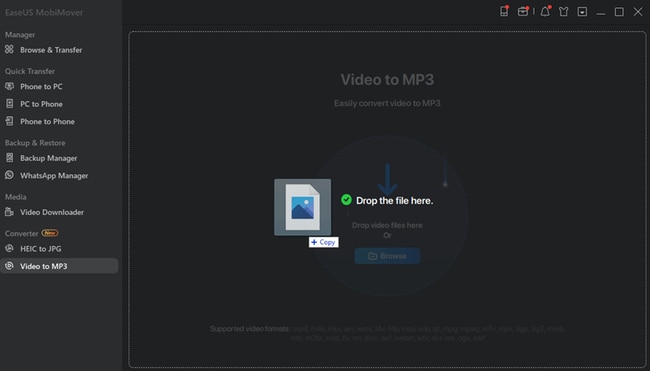
02Freemake Video Converter
Freemake Video Converter is the first 100% FREE MP3 converter for Windows 10 on this list! They keep the software updated from donations, so you can choose how much money you can spare for using the service! It’s a very simple software besides (as is shown in the image below). It does feature some video editing tools, but its main function is conversion (which includes video-to-audio conversion!)

03VSDC
Much like Freemake, our next MP3 converter for Windows 10 and 11, called VSDC, is completely FREE — as they run primarily on donations. That does mean that it’s not the most advanced program though — evident from the rather old-school interface (shown in the image below). But, regardless of the lack of abundance in tools, it should function just fine as an audio-video-converter for Windows 10 (and vice versa.)
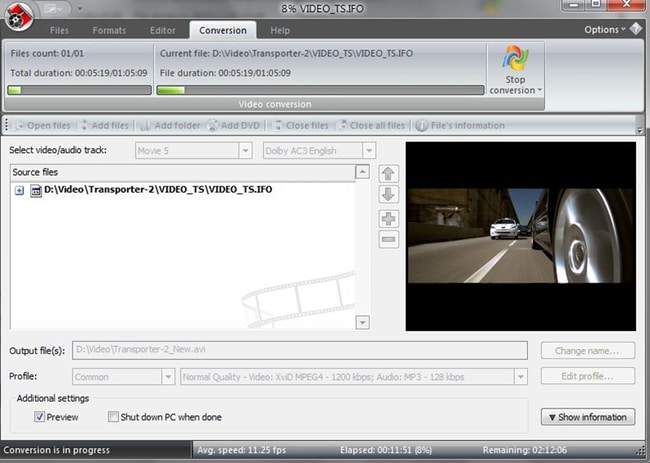
04Convertio.co
With Convertio.co, we break the mold a bit! This is not a software, but it does still work for Windows users — as it requires only that you have a working browser from which you can access the website (URL linked below!) As you can see from the image, it works much like most online MP3 converters — you upload a file from your desktop, wait for it to finish converting, and then download it!

05Free Convert
Free Convert is another online MP3 convert for Windows 10 users that would prefer not to download or install software. And, just like Covertio, it works by uploading the files you want to convert from your computer, waiting for the converters tool to finish converting it, and then downloading the finished product. It is, of course, FREE — but, similar to the first tool on this list, if you want to unlock some of its features, you’ll have to pay for the premium version.
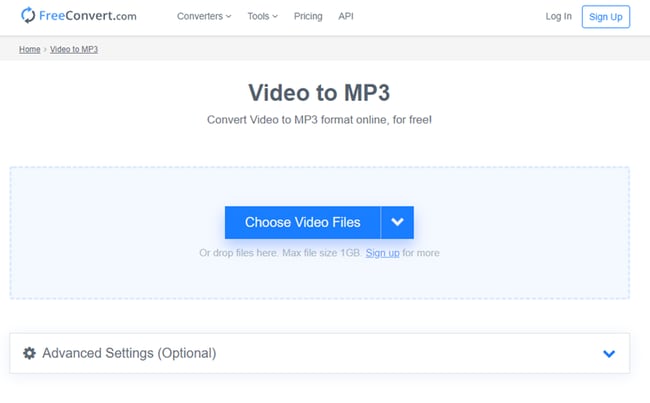
06DVDVideoSoft
With DVDVideoSoft, we’re back to an audio-video converter for Windows 10 that you have to download and install to work! It’s a FREEmium software too. That means that you’ll have to pay in order to unlock certain features. But, it works as a solid converter even without that.
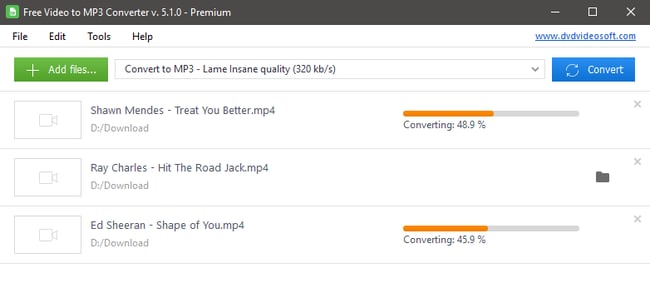
Part 2 6 Best Free and Paid Audio Editor for PC and Mac
For this next section, we turn our attention to a couple of MP3 editors (Windows 10 and Mac compatible.) This list will be a little more detailed than the first, since there are many differences between the tools that we’ll be introducing (both FREE and PAID), but it should give you a clear idea on which would work best for you.
01Wondershare Filmora
Operating System: Windows/Mac
Today’s Best Deals: US$89.99 (one-time)
The first on our list is the MP3 editor Windows 10 and Mac compatible, Wondershare Filmora Video Editor This is an advanced video editing software that you can use in order to work on just about any digital project — including, of course, editing your MP3 audio files.
Reasons to Buy:
● Lots of editing tools for MP3 files
● Exports high-quality end-products
● FREE to try, multiple-packages available
Reasons to Avoid:
● Premium software (subscription/one-time fee)
● Advanced tools might make it harder to get used to
● Download and installation is required
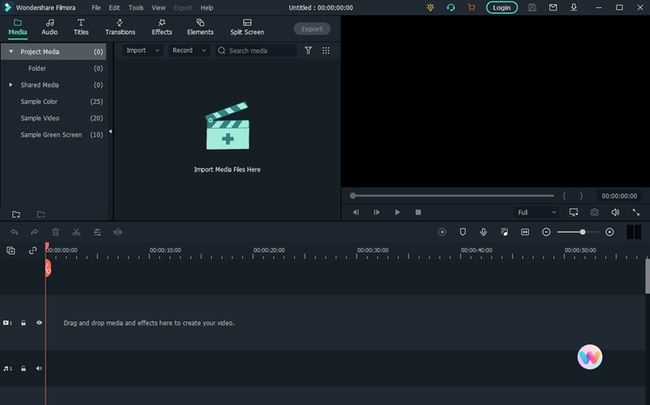
02Audacity
Operating System: Windows/Mac/Linux
Today’s Best Deals: FREE
Audacity is an MP3 editor (Windows 10, Max, and Linux compatible!) The difference between this tool and our first pick, Filmora Pro, is that Audacity is an open-source software — this means that it is free to use, but it also means that it might not be the most reliable as it is not updated quite as often.
Reasons to Buy:
● FREE, open-source software
● Advanced video and audio editing tools
● MP3 trimming/cutting feature
Reasons to Avoid:
● Not updated as often
● Confusing interface
● Difficult to use for beginners
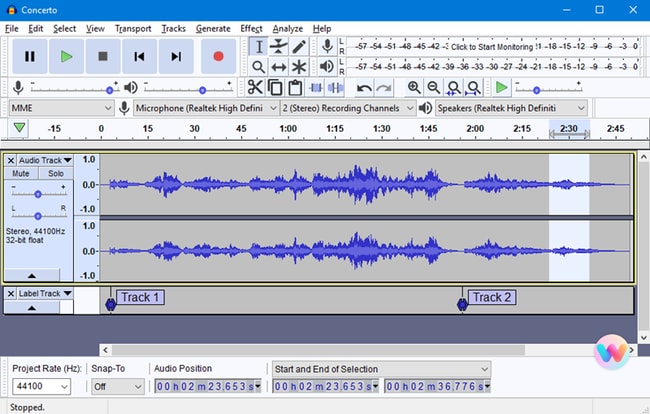
03Ashampoo Music Studio 8
Operating System: Windows
Today’s Best Deals: US$29.99
Next up is Ashampoo’s Music Studio 8! Here’s another freemium software that you can try for free — just to make sure it’s the tool that you’re looking for, but you’ll have to pay a price to use in its entirety! As you can see from the interface (shown in the image below) though, it’s quite the effective MP3 cutter for Windows 10 (among other things). So, if that’s what you’re looking for, then it’s a good choice to consider.
Reasons to Buy:
● Clean, modern interface
● Beginner-friendly editing tools
● One-time fee only
Reasons to Avoid:
● Freemium software (one-time payment required)
● Available only for Windows!
● Cannot support multiple tracks
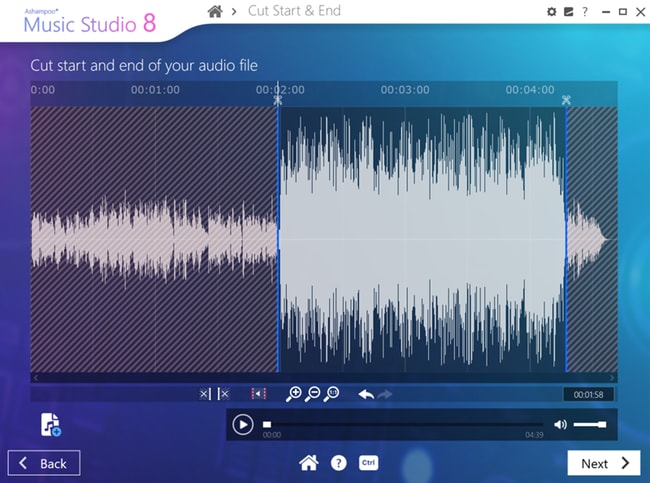
04Ocenaudio
Operating System: Windows/Mac/Linux
Today’s Best Deals: FREE
As far as audio-editing goes, you’re probably going to have a difficult time finding one that is as specialized as Ocenaudio. As you can probably guess from the name, it is, primarily, an audio editing tool. Making it a good choice if that’s all you’re looking for in a software, as it certainly keeps things simpler.
Reasons to Buy:
● Beginner-friendly audio editor
● Simple, clean interface
● Available for Windows/Mac/Linux
Reasons to Avoid:
● Older software
● Open-source, not updated as often
● Only an audio-editing software
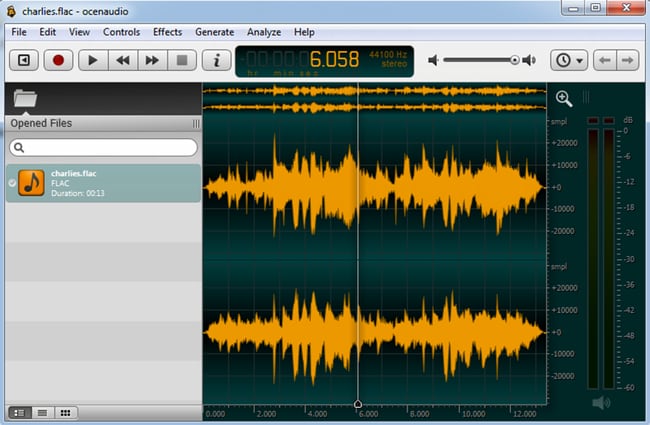
05Acoustica
Operating System: Windows
Today’s Best Deals: FREE
Our next pick is another open-source, MP3 editor for Windows 10. It’s called Acoustica. And, as you can see from the image shared below, it’s a fairly advanced audio editing tool. You should note, however, that the newer versions of this product are PAID (only older models are free), which is the topic of our discussion today.
Reasons to Buy:
● FREE, open-source product
● Advanced audio editing tools
● Advanced exporting formats
Reasons to Avoid:
● Older version of the software
● Updated version is PAID
● Available only for Windows
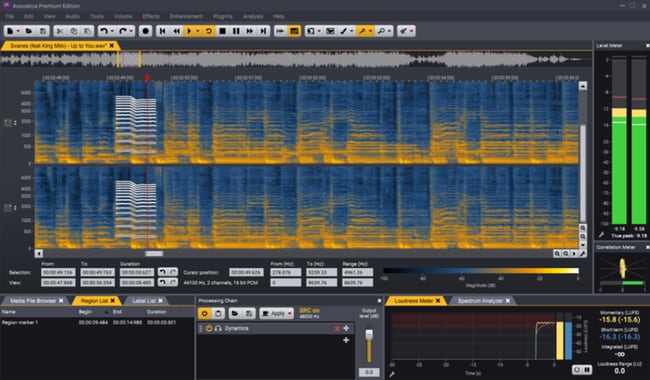
06Audiotool
Operating System: Windows/Mac/Linux
Today’s Best Deals: FREE
Finally, we finish things off with Audiotool, it’s certainly not your traditional audio editor (as is evident from the image shown below). But, the funky interface doesn’t mean that it won’t work for you! You never know, it might be exactly the kind that helps you zoom through your projects more quickly.
Reasons to Buy:
● FREE, open-source software
● Available for Windows/Mac/Linux users
● Advanced audio editing
Reasons to Avoid:
● Complex editing interface
● Requires internet to work (Linux)
● Not regularly updated
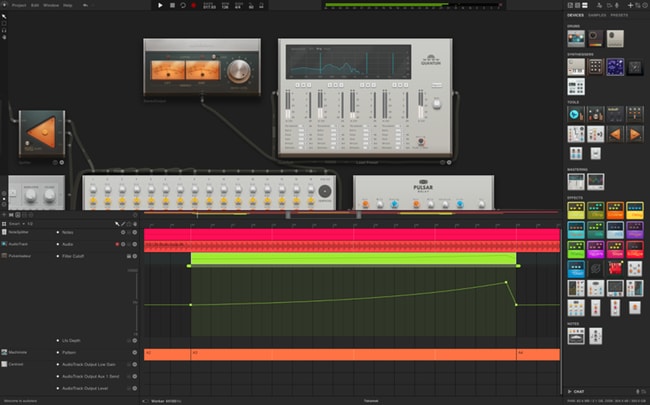
Part 3 5 MP3 Music Players for Windows 10/11 PC
The last of the lists in this article is a short one for the best MP3 players for Windows 10! This is a straightforward list, much like the first. And, we’ll be focusing on MP3 players for Windows 10 only (although some of these will work for Mac as well!)
01iTunes
Despite appearances, iTunes actually makes for a great MP3 player for Windows 10 users. After all, it’s interface is clean and it is regularly updated. So, you never have to deal with bugs! (And just in case you weren’t aware, you can add your own original audio to your iTunes library! So, it isn’t like you have to purchase media from the iTunes store just to listen to it.)

02Groove Music
Groove Music is a local Mp3 player for Windows 10 that you can download from the Microsoft App Store. It functions much like iTunes — in that you can add original music or audio to the app library (as well as purchase audio from the store — if that’s what you want.)
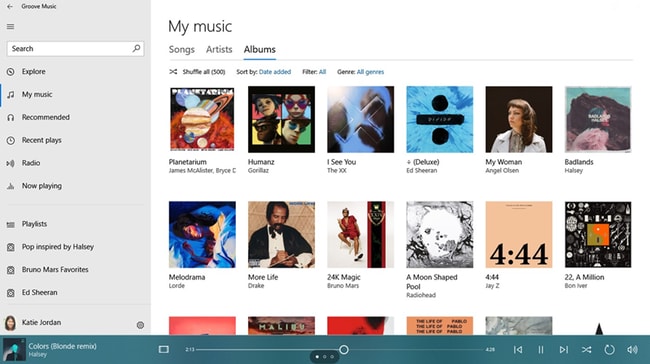
03Macgo Media Player
Our next pick, Macgo, is not strictly an MP3 player for Windows 10, but it can work for that purpose if that’s all you need it for. As a media player though, it does function as a video player as well. And, like our previous picks, it’s FREE so you don’t have to worry about paying in order to use it.
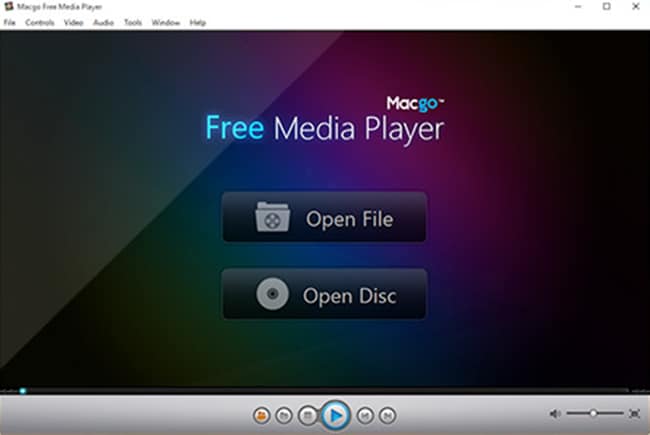
04PowerDVD
Again, our next pick is more of a general media player than strictly a MP3 Player for Windows 10 users, but it works just as well if all you’re looking for is to occasionally play the audio that you’ve converted or trimmed!
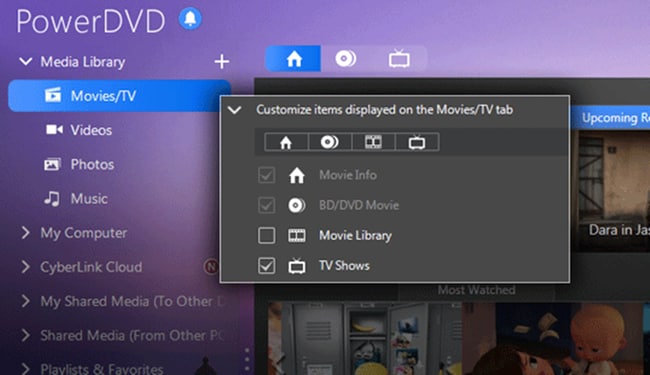
05Musicbee
We’re back to strictly MP3 players for Windows with Musicbee! The best part of this app is, undoubtedly, the fact that it has several view options. So, if you want, you have your audio playing from a mini audio player (rather than the full interface — as is shown below). It’s also useful for organizing your media collection!
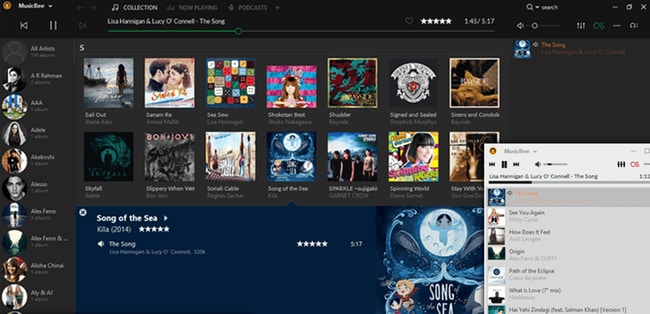
Part 4 How to Trim Mp3 on Windows 10 Easily
For this next part, we’re going to go over how you might go about trimming your converted audio with an MP3 cutter for Windows. (Note, a lot of the audio editors that we introduced in Part 2 of this article should be capable of this! And, they all work in much the same way.)
01Step 1: Launch MP3 Cutter for Windows 10! Start!
First, launch the MP3 cutter for Windows 10 that you downloaded.
For this example, we’ll be using Joyoshare Media Cutter. And, the way to start is to select the “Open” button, which will prompt you to choose which audio you want to cut.
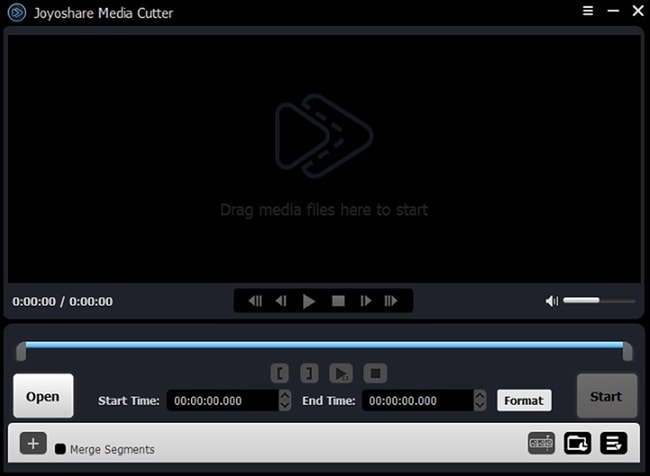
02Step 2: Choose Output Option
Next, select the output format that you want your audio to be exported in. (Most MP3 cutters for Windows 10 offers a variety for you to choose from).
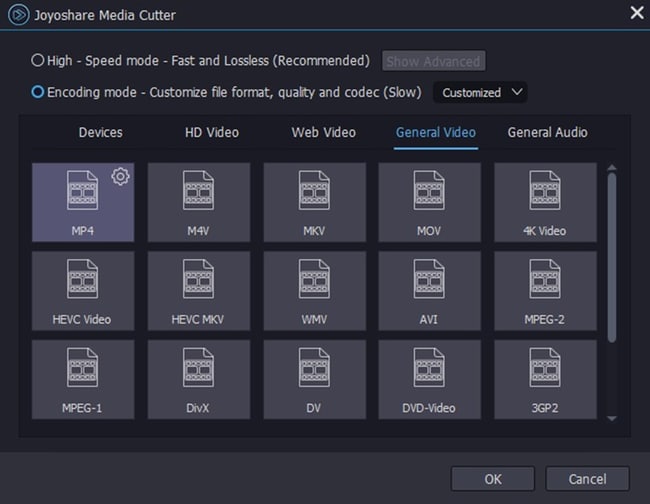
03Step 3: Select and Trim Mode!
Joyoshare has two methods of trimming available. The first is the select and trim mode, which is shown in the image below! For this, you use the sliders provider to select which portion of the audio you want to keep!

04Step 4: Use Encoder Trimmer
If you want a cleaner trim, you click the “Edit” icon beside the audio that you want to trim until you are moved to the encoder window (shown in the image below). This will allow you to pinpoint the best place to cut your audio!
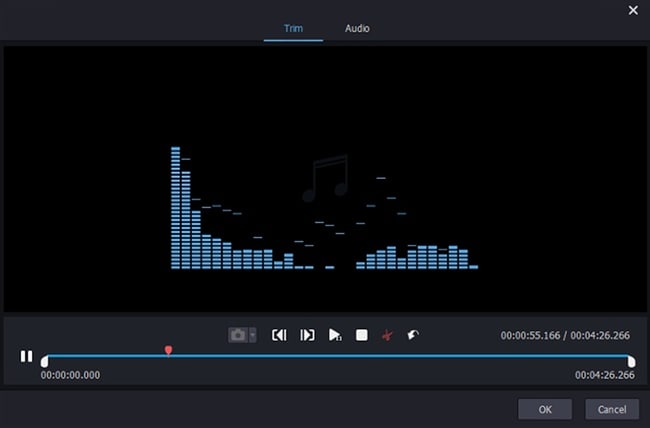
05Step 5: Save Your Audio!
Once you’re done trimming, remember to save!
With Joyoshare, the method of doing this is to select the “Start” button, which will prompt the trimmer to begin cutting the audio.
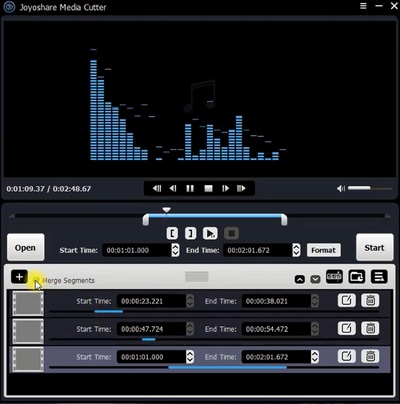
Key Takeaways from This Episode
● There are multiple MP3 converters for Windows and Mac that you can use in order to convert videos to an audio file that you can use for certain projects.
● Of course, if you want your finished project to sound clean, you’ll probably need a functional audio editor for that! And, for this matter, we recommend advanced video editing software like Filmora Pro.
● Just in case you want to review what your converted audio sounds like, consider one of the audio players that are available for Windows and Mac!
● If you find that your audio needs some trimming, a quick trim with an audio cutter should do the trick. It’s very simple to do!
We’ve got you there! In this article, not only have we compiled a list of the best FREE MP3 converters for Windows 10/11.
We’ve also included a list of the best MP3 editor Windows & Mac, and a list for the best MP3 player Windows & Mac! There’s even a quick tutorial in the end that can help you trim MP3 (Windows) files that you’ve converted so that you can more cleanly include it in your own project.
In this article
01 [6 Best Free MP3 Converter for Windows 10 / 11](#Part 1)
02 [6 Best Free and Paid Audio Editor for PC and Mac](#Part 2)
03 [5 MP3 Music Players for Windows 10/11 PC](#Part 3)
04 [How to Trim Mp3 on Windows 10 Easily](#Part 4)
Part 1 6 Best Free MP3 Converter for Windows 10 / 11
As promised, we start this off with the best audio converter (Windows 10/11) tools. We’ve decided to go very simple with this list, providing a brief description of all of the FREE MP3 Converters (Windows), a URL that will lead you to the website where you can get the converter, and an image that should show you how the converter’s interface looks like.
01EaseUs MobiMover
EaseUs MobiMover is an audio converter for Windows 10 and 11 that you can use in order to easily convert videos (in various formats) into MP3 (as is shown in the image below. It’s a FREEmium software though — which means that it’s use is limited until you purchase the paid version of the software.

02Freemake Video Converter
Freemake Video Converter is the first 100% FREE MP3 converter for Windows 10 on this list! They keep the software updated from donations, so you can choose how much money you can spare for using the service! It’s a very simple software besides (as is shown in the image below). It does feature some video editing tools, but its main function is conversion (which includes video-to-audio conversion!)

03VSDC
Much like Freemake, our next MP3 converter for Windows 10 and 11, called VSDC, is completely FREE — as they run primarily on donations. That does mean that it’s not the most advanced program though — evident from the rather old-school interface (shown in the image below). But, regardless of the lack of abundance in tools, it should function just fine as an audio-video-converter for Windows 10 (and vice versa.)

04Convertio.co
With Convertio.co, we break the mold a bit! This is not a software, but it does still work for Windows users — as it requires only that you have a working browser from which you can access the website (URL linked below!) As you can see from the image, it works much like most online MP3 converters — you upload a file from your desktop, wait for it to finish converting, and then download it!

05Free Convert
Free Convert is another online MP3 convert for Windows 10 users that would prefer not to download or install software. And, just like Covertio, it works by uploading the files you want to convert from your computer, waiting for the converters tool to finish converting it, and then downloading the finished product. It is, of course, FREE — but, similar to the first tool on this list, if you want to unlock some of its features, you’ll have to pay for the premium version.

06DVDVideoSoft
With DVDVideoSoft, we’re back to an audio-video converter for Windows 10 that you have to download and install to work! It’s a FREEmium software too. That means that you’ll have to pay in order to unlock certain features. But, it works as a solid converter even without that.

Part 2 6 Best Free and Paid Audio Editor for PC and Mac
For this next section, we turn our attention to a couple of MP3 editors (Windows 10 and Mac compatible.) This list will be a little more detailed than the first, since there are many differences between the tools that we’ll be introducing (both FREE and PAID), but it should give you a clear idea on which would work best for you.
01Wondershare Filmora
Operating System: Windows/Mac
Today’s Best Deals: US$89.99 (one-time)
The first on our list is the MP3 editor Windows 10 and Mac compatible, Wondershare Filmora Video Editor This is an advanced video editing software that you can use in order to work on just about any digital project — including, of course, editing your MP3 audio files.
Reasons to Buy:
● Lots of editing tools for MP3 files
● Exports high-quality end-products
● FREE to try, multiple-packages available
Reasons to Avoid:
● Premium software (subscription/one-time fee)
● Advanced tools might make it harder to get used to
● Download and installation is required

02Audacity
Operating System: Windows/Mac/Linux
Today’s Best Deals: FREE
Audacity is an MP3 editor (Windows 10, Max, and Linux compatible!) The difference between this tool and our first pick, Filmora Pro, is that Audacity is an open-source software — this means that it is free to use, but it also means that it might not be the most reliable as it is not updated quite as often.
Reasons to Buy:
● FREE, open-source software
● Advanced video and audio editing tools
● MP3 trimming/cutting feature
Reasons to Avoid:
● Not updated as often
● Confusing interface
● Difficult to use for beginners

03Ashampoo Music Studio 8
Operating System: Windows
Today’s Best Deals: US$29.99
Next up is Ashampoo’s Music Studio 8! Here’s another freemium software that you can try for free — just to make sure it’s the tool that you’re looking for, but you’ll have to pay a price to use in its entirety! As you can see from the interface (shown in the image below) though, it’s quite the effective MP3 cutter for Windows 10 (among other things). So, if that’s what you’re looking for, then it’s a good choice to consider.
Reasons to Buy:
● Clean, modern interface
● Beginner-friendly editing tools
● One-time fee only
Reasons to Avoid:
● Freemium software (one-time payment required)
● Available only for Windows!
● Cannot support multiple tracks

04Ocenaudio
Operating System: Windows/Mac/Linux
Today’s Best Deals: FREE
As far as audio-editing goes, you’re probably going to have a difficult time finding one that is as specialized as Ocenaudio. As you can probably guess from the name, it is, primarily, an audio editing tool. Making it a good choice if that’s all you’re looking for in a software, as it certainly keeps things simpler.
Reasons to Buy:
● Beginner-friendly audio editor
● Simple, clean interface
● Available for Windows/Mac/Linux
Reasons to Avoid:
● Older software
● Open-source, not updated as often
● Only an audio-editing software

05Acoustica
Operating System: Windows
Today’s Best Deals: FREE
Our next pick is another open-source, MP3 editor for Windows 10. It’s called Acoustica. And, as you can see from the image shared below, it’s a fairly advanced audio editing tool. You should note, however, that the newer versions of this product are PAID (only older models are free), which is the topic of our discussion today.
Reasons to Buy:
● FREE, open-source product
● Advanced audio editing tools
● Advanced exporting formats
Reasons to Avoid:
● Older version of the software
● Updated version is PAID
● Available only for Windows

06Audiotool
Operating System: Windows/Mac/Linux
Today’s Best Deals: FREE
Finally, we finish things off with Audiotool, it’s certainly not your traditional audio editor (as is evident from the image shown below). But, the funky interface doesn’t mean that it won’t work for you! You never know, it might be exactly the kind that helps you zoom through your projects more quickly.
Reasons to Buy:
● FREE, open-source software
● Available for Windows/Mac/Linux users
● Advanced audio editing
Reasons to Avoid:
● Complex editing interface
● Requires internet to work (Linux)
● Not regularly updated

Part 3 5 MP3 Music Players for Windows 10/11 PC
The last of the lists in this article is a short one for the best MP3 players for Windows 10! This is a straightforward list, much like the first. And, we’ll be focusing on MP3 players for Windows 10 only (although some of these will work for Mac as well!)
01iTunes
Despite appearances, iTunes actually makes for a great MP3 player for Windows 10 users. After all, it’s interface is clean and it is regularly updated. So, you never have to deal with bugs! (And just in case you weren’t aware, you can add your own original audio to your iTunes library! So, it isn’t like you have to purchase media from the iTunes store just to listen to it.)

02Groove Music
Groove Music is a local Mp3 player for Windows 10 that you can download from the Microsoft App Store. It functions much like iTunes — in that you can add original music or audio to the app library (as well as purchase audio from the store — if that’s what you want.)

03Macgo Media Player
Our next pick, Macgo, is not strictly an MP3 player for Windows 10, but it can work for that purpose if that’s all you need it for. As a media player though, it does function as a video player as well. And, like our previous picks, it’s FREE so you don’t have to worry about paying in order to use it.

04PowerDVD
Again, our next pick is more of a general media player than strictly a MP3 Player for Windows 10 users, but it works just as well if all you’re looking for is to occasionally play the audio that you’ve converted or trimmed!

05Musicbee
We’re back to strictly MP3 players for Windows with Musicbee! The best part of this app is, undoubtedly, the fact that it has several view options. So, if you want, you have your audio playing from a mini audio player (rather than the full interface — as is shown below). It’s also useful for organizing your media collection!

Part 4 How to Trim Mp3 on Windows 10 Easily
For this next part, we’re going to go over how you might go about trimming your converted audio with an MP3 cutter for Windows. (Note, a lot of the audio editors that we introduced in Part 2 of this article should be capable of this! And, they all work in much the same way.)
01Step 1: Launch MP3 Cutter for Windows 10! Start!
First, launch the MP3 cutter for Windows 10 that you downloaded.
For this example, we’ll be using Joyoshare Media Cutter. And, the way to start is to select the “Open” button, which will prompt you to choose which audio you want to cut.

02Step 2: Choose Output Option
Next, select the output format that you want your audio to be exported in. (Most MP3 cutters for Windows 10 offers a variety for you to choose from).

03Step 3: Select and Trim Mode!
Joyoshare has two methods of trimming available. The first is the select and trim mode, which is shown in the image below! For this, you use the sliders provider to select which portion of the audio you want to keep!

04Step 4: Use Encoder Trimmer
If you want a cleaner trim, you click the “Edit” icon beside the audio that you want to trim until you are moved to the encoder window (shown in the image below). This will allow you to pinpoint the best place to cut your audio!

05Step 5: Save Your Audio!
Once you’re done trimming, remember to save!
With Joyoshare, the method of doing this is to select the “Start” button, which will prompt the trimmer to begin cutting the audio.

Key Takeaways from This Episode
● There are multiple MP3 converters for Windows and Mac that you can use in order to convert videos to an audio file that you can use for certain projects.
● Of course, if you want your finished project to sound clean, you’ll probably need a functional audio editor for that! And, for this matter, we recommend advanced video editing software like Filmora Pro.
● Just in case you want to review what your converted audio sounds like, consider one of the audio players that are available for Windows and Mac!
● If you find that your audio needs some trimming, a quick trim with an audio cutter should do the trick. It’s very simple to do!
We’ve got you there! In this article, not only have we compiled a list of the best FREE MP3 converters for Windows 10/11.
We’ve also included a list of the best MP3 editor Windows & Mac, and a list for the best MP3 player Windows & Mac! There’s even a quick tutorial in the end that can help you trim MP3 (Windows) files that you’ve converted so that you can more cleanly include it in your own project.
In this article
01 [6 Best Free MP3 Converter for Windows 10 / 11](#Part 1)
02 [6 Best Free and Paid Audio Editor for PC and Mac](#Part 2)
03 [5 MP3 Music Players for Windows 10/11 PC](#Part 3)
04 [How to Trim Mp3 on Windows 10 Easily](#Part 4)
Part 1 6 Best Free MP3 Converter for Windows 10 / 11
As promised, we start this off with the best audio converter (Windows 10/11) tools. We’ve decided to go very simple with this list, providing a brief description of all of the FREE MP3 Converters (Windows), a URL that will lead you to the website where you can get the converter, and an image that should show you how the converter’s interface looks like.
01EaseUs MobiMover
EaseUs MobiMover is an audio converter for Windows 10 and 11 that you can use in order to easily convert videos (in various formats) into MP3 (as is shown in the image below. It’s a FREEmium software though — which means that it’s use is limited until you purchase the paid version of the software.

02Freemake Video Converter
Freemake Video Converter is the first 100% FREE MP3 converter for Windows 10 on this list! They keep the software updated from donations, so you can choose how much money you can spare for using the service! It’s a very simple software besides (as is shown in the image below). It does feature some video editing tools, but its main function is conversion (which includes video-to-audio conversion!)

03VSDC
Much like Freemake, our next MP3 converter for Windows 10 and 11, called VSDC, is completely FREE — as they run primarily on donations. That does mean that it’s not the most advanced program though — evident from the rather old-school interface (shown in the image below). But, regardless of the lack of abundance in tools, it should function just fine as an audio-video-converter for Windows 10 (and vice versa.)

04Convertio.co
With Convertio.co, we break the mold a bit! This is not a software, but it does still work for Windows users — as it requires only that you have a working browser from which you can access the website (URL linked below!) As you can see from the image, it works much like most online MP3 converters — you upload a file from your desktop, wait for it to finish converting, and then download it!

05Free Convert
Free Convert is another online MP3 convert for Windows 10 users that would prefer not to download or install software. And, just like Covertio, it works by uploading the files you want to convert from your computer, waiting for the converters tool to finish converting it, and then downloading the finished product. It is, of course, FREE — but, similar to the first tool on this list, if you want to unlock some of its features, you’ll have to pay for the premium version.

06DVDVideoSoft
With DVDVideoSoft, we’re back to an audio-video converter for Windows 10 that you have to download and install to work! It’s a FREEmium software too. That means that you’ll have to pay in order to unlock certain features. But, it works as a solid converter even without that.

Part 2 6 Best Free and Paid Audio Editor for PC and Mac
For this next section, we turn our attention to a couple of MP3 editors (Windows 10 and Mac compatible.) This list will be a little more detailed than the first, since there are many differences between the tools that we’ll be introducing (both FREE and PAID), but it should give you a clear idea on which would work best for you.
01Wondershare Filmora
Operating System: Windows/Mac
Today’s Best Deals: US$89.99 (one-time)
The first on our list is the MP3 editor Windows 10 and Mac compatible, Wondershare Filmora Video Editor This is an advanced video editing software that you can use in order to work on just about any digital project — including, of course, editing your MP3 audio files.
Reasons to Buy:
● Lots of editing tools for MP3 files
● Exports high-quality end-products
● FREE to try, multiple-packages available
Reasons to Avoid:
● Premium software (subscription/one-time fee)
● Advanced tools might make it harder to get used to
● Download and installation is required

02Audacity
Operating System: Windows/Mac/Linux
Today’s Best Deals: FREE
Audacity is an MP3 editor (Windows 10, Max, and Linux compatible!) The difference between this tool and our first pick, Filmora Pro, is that Audacity is an open-source software — this means that it is free to use, but it also means that it might not be the most reliable as it is not updated quite as often.
Reasons to Buy:
● FREE, open-source software
● Advanced video and audio editing tools
● MP3 trimming/cutting feature
Reasons to Avoid:
● Not updated as often
● Confusing interface
● Difficult to use for beginners

03Ashampoo Music Studio 8
Operating System: Windows
Today’s Best Deals: US$29.99
Next up is Ashampoo’s Music Studio 8! Here’s another freemium software that you can try for free — just to make sure it’s the tool that you’re looking for, but you’ll have to pay a price to use in its entirety! As you can see from the interface (shown in the image below) though, it’s quite the effective MP3 cutter for Windows 10 (among other things). So, if that’s what you’re looking for, then it’s a good choice to consider.
Reasons to Buy:
● Clean, modern interface
● Beginner-friendly editing tools
● One-time fee only
Reasons to Avoid:
● Freemium software (one-time payment required)
● Available only for Windows!
● Cannot support multiple tracks

04Ocenaudio
Operating System: Windows/Mac/Linux
Today’s Best Deals: FREE
As far as audio-editing goes, you’re probably going to have a difficult time finding one that is as specialized as Ocenaudio. As you can probably guess from the name, it is, primarily, an audio editing tool. Making it a good choice if that’s all you’re looking for in a software, as it certainly keeps things simpler.
Reasons to Buy:
● Beginner-friendly audio editor
● Simple, clean interface
● Available for Windows/Mac/Linux
Reasons to Avoid:
● Older software
● Open-source, not updated as often
● Only an audio-editing software

05Acoustica
Operating System: Windows
Today’s Best Deals: FREE
Our next pick is another open-source, MP3 editor for Windows 10. It’s called Acoustica. And, as you can see from the image shared below, it’s a fairly advanced audio editing tool. You should note, however, that the newer versions of this product are PAID (only older models are free), which is the topic of our discussion today.
Reasons to Buy:
● FREE, open-source product
● Advanced audio editing tools
● Advanced exporting formats
Reasons to Avoid:
● Older version of the software
● Updated version is PAID
● Available only for Windows

06Audiotool
Operating System: Windows/Mac/Linux
Today’s Best Deals: FREE
Finally, we finish things off with Audiotool, it’s certainly not your traditional audio editor (as is evident from the image shown below). But, the funky interface doesn’t mean that it won’t work for you! You never know, it might be exactly the kind that helps you zoom through your projects more quickly.
Reasons to Buy:
● FREE, open-source software
● Available for Windows/Mac/Linux users
● Advanced audio editing
Reasons to Avoid:
● Complex editing interface
● Requires internet to work (Linux)
● Not regularly updated

Part 3 5 MP3 Music Players for Windows 10/11 PC
The last of the lists in this article is a short one for the best MP3 players for Windows 10! This is a straightforward list, much like the first. And, we’ll be focusing on MP3 players for Windows 10 only (although some of these will work for Mac as well!)
01iTunes
Despite appearances, iTunes actually makes for a great MP3 player for Windows 10 users. After all, it’s interface is clean and it is regularly updated. So, you never have to deal with bugs! (And just in case you weren’t aware, you can add your own original audio to your iTunes library! So, it isn’t like you have to purchase media from the iTunes store just to listen to it.)

02Groove Music
Groove Music is a local Mp3 player for Windows 10 that you can download from the Microsoft App Store. It functions much like iTunes — in that you can add original music or audio to the app library (as well as purchase audio from the store — if that’s what you want.)

03Macgo Media Player
Our next pick, Macgo, is not strictly an MP3 player for Windows 10, but it can work for that purpose if that’s all you need it for. As a media player though, it does function as a video player as well. And, like our previous picks, it’s FREE so you don’t have to worry about paying in order to use it.

04PowerDVD
Again, our next pick is more of a general media player than strictly a MP3 Player for Windows 10 users, but it works just as well if all you’re looking for is to occasionally play the audio that you’ve converted or trimmed!

05Musicbee
We’re back to strictly MP3 players for Windows with Musicbee! The best part of this app is, undoubtedly, the fact that it has several view options. So, if you want, you have your audio playing from a mini audio player (rather than the full interface — as is shown below). It’s also useful for organizing your media collection!

Part 4 How to Trim Mp3 on Windows 10 Easily
For this next part, we’re going to go over how you might go about trimming your converted audio with an MP3 cutter for Windows. (Note, a lot of the audio editors that we introduced in Part 2 of this article should be capable of this! And, they all work in much the same way.)
01Step 1: Launch MP3 Cutter for Windows 10! Start!
First, launch the MP3 cutter for Windows 10 that you downloaded.
For this example, we’ll be using Joyoshare Media Cutter. And, the way to start is to select the “Open” button, which will prompt you to choose which audio you want to cut.

02Step 2: Choose Output Option
Next, select the output format that you want your audio to be exported in. (Most MP3 cutters for Windows 10 offers a variety for you to choose from).

03Step 3: Select and Trim Mode!
Joyoshare has two methods of trimming available. The first is the select and trim mode, which is shown in the image below! For this, you use the sliders provider to select which portion of the audio you want to keep!

04Step 4: Use Encoder Trimmer
If you want a cleaner trim, you click the “Edit” icon beside the audio that you want to trim until you are moved to the encoder window (shown in the image below). This will allow you to pinpoint the best place to cut your audio!

05Step 5: Save Your Audio!
Once you’re done trimming, remember to save!
With Joyoshare, the method of doing this is to select the “Start” button, which will prompt the trimmer to begin cutting the audio.

Key Takeaways from This Episode
● There are multiple MP3 converters for Windows and Mac that you can use in order to convert videos to an audio file that you can use for certain projects.
● Of course, if you want your finished project to sound clean, you’ll probably need a functional audio editor for that! And, for this matter, we recommend advanced video editing software like Filmora Pro.
● Just in case you want to review what your converted audio sounds like, consider one of the audio players that are available for Windows and Mac!
● If you find that your audio needs some trimming, a quick trim with an audio cutter should do the trick. It’s very simple to do!
We’ve got you there! In this article, not only have we compiled a list of the best FREE MP3 converters for Windows 10/11.
We’ve also included a list of the best MP3 editor Windows & Mac, and a list for the best MP3 player Windows & Mac! There’s even a quick tutorial in the end that can help you trim MP3 (Windows) files that you’ve converted so that you can more cleanly include it in your own project.
In this article
01 [6 Best Free MP3 Converter for Windows 10 / 11](#Part 1)
02 [6 Best Free and Paid Audio Editor for PC and Mac](#Part 2)
03 [5 MP3 Music Players for Windows 10/11 PC](#Part 3)
04 [How to Trim Mp3 on Windows 10 Easily](#Part 4)
Part 1 6 Best Free MP3 Converter for Windows 10 / 11
As promised, we start this off with the best audio converter (Windows 10/11) tools. We’ve decided to go very simple with this list, providing a brief description of all of the FREE MP3 Converters (Windows), a URL that will lead you to the website where you can get the converter, and an image that should show you how the converter’s interface looks like.
01EaseUs MobiMover
EaseUs MobiMover is an audio converter for Windows 10 and 11 that you can use in order to easily convert videos (in various formats) into MP3 (as is shown in the image below. It’s a FREEmium software though — which means that it’s use is limited until you purchase the paid version of the software.

02Freemake Video Converter
Freemake Video Converter is the first 100% FREE MP3 converter for Windows 10 on this list! They keep the software updated from donations, so you can choose how much money you can spare for using the service! It’s a very simple software besides (as is shown in the image below). It does feature some video editing tools, but its main function is conversion (which includes video-to-audio conversion!)

03VSDC
Much like Freemake, our next MP3 converter for Windows 10 and 11, called VSDC, is completely FREE — as they run primarily on donations. That does mean that it’s not the most advanced program though — evident from the rather old-school interface (shown in the image below). But, regardless of the lack of abundance in tools, it should function just fine as an audio-video-converter for Windows 10 (and vice versa.)

04Convertio.co
With Convertio.co, we break the mold a bit! This is not a software, but it does still work for Windows users — as it requires only that you have a working browser from which you can access the website (URL linked below!) As you can see from the image, it works much like most online MP3 converters — you upload a file from your desktop, wait for it to finish converting, and then download it!

05Free Convert
Free Convert is another online MP3 convert for Windows 10 users that would prefer not to download or install software. And, just like Covertio, it works by uploading the files you want to convert from your computer, waiting for the converters tool to finish converting it, and then downloading the finished product. It is, of course, FREE — but, similar to the first tool on this list, if you want to unlock some of its features, you’ll have to pay for the premium version.

06DVDVideoSoft
With DVDVideoSoft, we’re back to an audio-video converter for Windows 10 that you have to download and install to work! It’s a FREEmium software too. That means that you’ll have to pay in order to unlock certain features. But, it works as a solid converter even without that.

Part 2 6 Best Free and Paid Audio Editor for PC and Mac
For this next section, we turn our attention to a couple of MP3 editors (Windows 10 and Mac compatible.) This list will be a little more detailed than the first, since there are many differences between the tools that we’ll be introducing (both FREE and PAID), but it should give you a clear idea on which would work best for you.
01Wondershare Filmora
Operating System: Windows/Mac
Today’s Best Deals: US$89.99 (one-time)
The first on our list is the MP3 editor Windows 10 and Mac compatible, Wondershare Filmora Video Editor This is an advanced video editing software that you can use in order to work on just about any digital project — including, of course, editing your MP3 audio files.
Reasons to Buy:
● Lots of editing tools for MP3 files
● Exports high-quality end-products
● FREE to try, multiple-packages available
Reasons to Avoid:
● Premium software (subscription/one-time fee)
● Advanced tools might make it harder to get used to
● Download and installation is required

02Audacity
Operating System: Windows/Mac/Linux
Today’s Best Deals: FREE
Audacity is an MP3 editor (Windows 10, Max, and Linux compatible!) The difference between this tool and our first pick, Filmora Pro, is that Audacity is an open-source software — this means that it is free to use, but it also means that it might not be the most reliable as it is not updated quite as often.
Reasons to Buy:
● FREE, open-source software
● Advanced video and audio editing tools
● MP3 trimming/cutting feature
Reasons to Avoid:
● Not updated as often
● Confusing interface
● Difficult to use for beginners

03Ashampoo Music Studio 8
Operating System: Windows
Today’s Best Deals: US$29.99
Next up is Ashampoo’s Music Studio 8! Here’s another freemium software that you can try for free — just to make sure it’s the tool that you’re looking for, but you’ll have to pay a price to use in its entirety! As you can see from the interface (shown in the image below) though, it’s quite the effective MP3 cutter for Windows 10 (among other things). So, if that’s what you’re looking for, then it’s a good choice to consider.
Reasons to Buy:
● Clean, modern interface
● Beginner-friendly editing tools
● One-time fee only
Reasons to Avoid:
● Freemium software (one-time payment required)
● Available only for Windows!
● Cannot support multiple tracks

04Ocenaudio
Operating System: Windows/Mac/Linux
Today’s Best Deals: FREE
As far as audio-editing goes, you’re probably going to have a difficult time finding one that is as specialized as Ocenaudio. As you can probably guess from the name, it is, primarily, an audio editing tool. Making it a good choice if that’s all you’re looking for in a software, as it certainly keeps things simpler.
Reasons to Buy:
● Beginner-friendly audio editor
● Simple, clean interface
● Available for Windows/Mac/Linux
Reasons to Avoid:
● Older software
● Open-source, not updated as often
● Only an audio-editing software

05Acoustica
Operating System: Windows
Today’s Best Deals: FREE
Our next pick is another open-source, MP3 editor for Windows 10. It’s called Acoustica. And, as you can see from the image shared below, it’s a fairly advanced audio editing tool. You should note, however, that the newer versions of this product are PAID (only older models are free), which is the topic of our discussion today.
Reasons to Buy:
● FREE, open-source product
● Advanced audio editing tools
● Advanced exporting formats
Reasons to Avoid:
● Older version of the software
● Updated version is PAID
● Available only for Windows

06Audiotool
Operating System: Windows/Mac/Linux
Today’s Best Deals: FREE
Finally, we finish things off with Audiotool, it’s certainly not your traditional audio editor (as is evident from the image shown below). But, the funky interface doesn’t mean that it won’t work for you! You never know, it might be exactly the kind that helps you zoom through your projects more quickly.
Reasons to Buy:
● FREE, open-source software
● Available for Windows/Mac/Linux users
● Advanced audio editing
Reasons to Avoid:
● Complex editing interface
● Requires internet to work (Linux)
● Not regularly updated

Part 3 5 MP3 Music Players for Windows 10/11 PC
The last of the lists in this article is a short one for the best MP3 players for Windows 10! This is a straightforward list, much like the first. And, we’ll be focusing on MP3 players for Windows 10 only (although some of these will work for Mac as well!)
01iTunes
Despite appearances, iTunes actually makes for a great MP3 player for Windows 10 users. After all, it’s interface is clean and it is regularly updated. So, you never have to deal with bugs! (And just in case you weren’t aware, you can add your own original audio to your iTunes library! So, it isn’t like you have to purchase media from the iTunes store just to listen to it.)

02Groove Music
Groove Music is a local Mp3 player for Windows 10 that you can download from the Microsoft App Store. It functions much like iTunes — in that you can add original music or audio to the app library (as well as purchase audio from the store — if that’s what you want.)

03Macgo Media Player
Our next pick, Macgo, is not strictly an MP3 player for Windows 10, but it can work for that purpose if that’s all you need it for. As a media player though, it does function as a video player as well. And, like our previous picks, it’s FREE so you don’t have to worry about paying in order to use it.

04PowerDVD
Again, our next pick is more of a general media player than strictly a MP3 Player for Windows 10 users, but it works just as well if all you’re looking for is to occasionally play the audio that you’ve converted or trimmed!

05Musicbee
We’re back to strictly MP3 players for Windows with Musicbee! The best part of this app is, undoubtedly, the fact that it has several view options. So, if you want, you have your audio playing from a mini audio player (rather than the full interface — as is shown below). It’s also useful for organizing your media collection!

Part 4 How to Trim Mp3 on Windows 10 Easily
For this next part, we’re going to go over how you might go about trimming your converted audio with an MP3 cutter for Windows. (Note, a lot of the audio editors that we introduced in Part 2 of this article should be capable of this! And, they all work in much the same way.)
01Step 1: Launch MP3 Cutter for Windows 10! Start!
First, launch the MP3 cutter for Windows 10 that you downloaded.
For this example, we’ll be using Joyoshare Media Cutter. And, the way to start is to select the “Open” button, which will prompt you to choose which audio you want to cut.

02Step 2: Choose Output Option
Next, select the output format that you want your audio to be exported in. (Most MP3 cutters for Windows 10 offers a variety for you to choose from).

03Step 3: Select and Trim Mode!
Joyoshare has two methods of trimming available. The first is the select and trim mode, which is shown in the image below! For this, you use the sliders provider to select which portion of the audio you want to keep!

04Step 4: Use Encoder Trimmer
If you want a cleaner trim, you click the “Edit” icon beside the audio that you want to trim until you are moved to the encoder window (shown in the image below). This will allow you to pinpoint the best place to cut your audio!

05Step 5: Save Your Audio!
Once you’re done trimming, remember to save!
With Joyoshare, the method of doing this is to select the “Start” button, which will prompt the trimmer to begin cutting the audio.

Key Takeaways from This Episode
● There are multiple MP3 converters for Windows and Mac that you can use in order to convert videos to an audio file that you can use for certain projects.
● Of course, if you want your finished project to sound clean, you’ll probably need a functional audio editor for that! And, for this matter, we recommend advanced video editing software like Filmora Pro.
● Just in case you want to review what your converted audio sounds like, consider one of the audio players that are available for Windows and Mac!
● If you find that your audio needs some trimming, a quick trim with an audio cutter should do the trick. It’s very simple to do!
Also read:
- Top Aspect Ratio Conversion Tools on the Web for 2024
- New In 2024, FCPX Audio Techniques Mastering L-Cuts, J-Cuts, and Beyond
- Videopad Video Editor Review Does It Live Up to the Hype, In 2024
- New In 2024, Get VirtualDub to Optimize Your MPEG2 Video Storage
- Updated 2024 Approved From Novice to Pro Expert Advice on YouTub
- Make Unforgettable Video Invites with These Free Online Tools for 2024
- Updated VLLO for Mac The Complete Package - Download and Alternatives
- Updated In 2024, Repeat and Replay 10 Best Free Online Video Loopers
- New Best Free Online Face Generators to Create Fake Faces for 2024
- Updated Revolutionize Your Classroom Top Animation Tools for Teachers
- New 2024 Approved Mac Video Maker Professional Video Editing Software
- 2024 Approved Top Linux Video Editors for Adobe Premiere Users
- New Transform Your Memories Video Editing Secrets for Beginners
- New In 2024, Avidemux Sound Problems? Heres How to Fix Them Quickly
- New FCP Transition Tutorial 3 Easy Steps to Enhance Your Footage for 2024
- New In 2024, One-Stop Video Editor Shop Best Solutions for Windows, Mac, Mobile, and Linux
- Vertical by Design Optimizing Your Mobile Video Strategy for 2024
- New In 2024, Final Cut Pro for Students Unbeatable Prices You Wont Want to Miss
- Updated Regular Videos to VR Masterpieces A Guide to the Best Converters
- New In 2024, Maximizing Mobile Engagement Best Practices for Vertical Content
- In 2024, Resize and Refine The Art of Cropping Videos in Avidemux
- Updated Unleash Your Creativity Making Videos From Photos and Soundtracks
- Updated Top 3D Animation Software for Mobile Devices (Free to Use)
- New Free and Fabulous The 5 Best Online Tone Generators Out There for 2024
- Updated 2024 Approved The Ultimate Guide to Video Editing on Mac OS X Yosemite
- New 2024 Approved Bokeh Perfection Top-Rated Mobile Apps for Photography Enthusiasts
- Updated 2024 Approved The Ultimate Cheat Sheet Mastering Facebook Video Aspect Ratios
- New Slow Down Time Using Windows Live Movie Makers Slow Motion Feature
- Updated In 2024, FCPX Cinematography How to Create Visually Stunning Videos
- Updated 2024 Approved The Best Free Video Editing Tools for AVI Format
- Updated Unleash Your Creativity The Best Video Editing Apps for 2024
- New 2024 Approved VLLO Mac Download Plus, Top Alternative Choices
- Updated Ditch iMovie 10 Fantastic Android Video Editors You Should Try for 2024
- Updated In 2024, The Art of Cartoonization How to Transform Videos Into Cartoons
- New In 2024, From Ingest to Delivery Mastering Video Import and Export in Adobe Premiere
- New 2024 Approved Are You Searching for the Best Online Lyrics Video Maker? Here We Have Listed some of the Greatest Tools that Allow Effortless Video Editing to Add Attractive Lyrics. Read Ahead and Find the Tool that Best Fits Your Requirements
- New MPEG Video Splitting Made Easy Top 5 Free Tools
- Updated In 2024, Free Video Editing Apps for Chrome OS A Comprehensive List
- 2024 Approved No-Cost Solutions The Best Free Online Video Merger Options
- Updated In 2024, In This Article We Are Going to Take You Through 15 Best Apps You Can Use to Cartoon Yourself and Increase the Number of Likes Your Posts on All Major Social Media Platforms Are Getting
- Updated Unleash Your Creativity Best Free and Open-Source Video Editors for 2024
- New In 2024, Take Your Videos to the Next Level Editing Tips and Tricks
- Solutions to Spy on ZTE Axon 40 Lite with and without jailbreak | Dr.fone
- In 2024, How To Remove or Bypass Knox Enrollment Service On Itel A70
- How to recover deleted photos from Android Gallery without backup on Huawei Nova Y71
- Unlock android phone if you forget the Y200e 5G password or pattern lock
- 5 Ways to Transfer Music from Apple iPhone 11 Pro to Android | Dr.fone
- How Do You Get Sun Stone Evolutions in Pokémon For Realme C67 4G? | Dr.fone
- 6 Ways to Change Spotify Location On Your Apple iPhone SE (2020) | Dr.fone
- In 2024, Best 3 Xiaomi Redmi 12 Emulator for Mac to Run Your Wanted Android Apps | Dr.fone
- Ultimate Guide to Free PPTP VPN For Beginners On Huawei P60 | Dr.fone
- Ultimate Guide from iPhone 8 Plus iCloud Activation Lock Bypass
- How to Change Netflix Location to Get More Country Version On Poco X5 | Dr.fone
- In 2024, 5 Ways to Move Contacts From Honor Magic V2 to iPhone (13/14/15) | Dr.fone
- In 2024, The Ultimate Guide to Get the Rare Candy on Pokemon Go Fire Red On Lava Yuva 3 | Dr.fone
- Use Device Manager to identify malfunctioning drivers with Windows Device Manager on Windows 11 & 10
- How to Soft Reset Honor Magic Vs 2 phone? | Dr.fone
- New 2024 Approved The Ultimate FCPX Captioning Guide Best Practices
- How to recover deleted photos from Android Gallery without backup on F5 Pro 5G
- Title: Updated Resize Like a Pro Tips for Converting Horizontal Videos to Vertical
- Author: MdadeLe
- Created at : 2024-05-19 08:26:25
- Updated at : 2024-05-20 08:26:25
- Link: https://smart-video-editing.techidaily.com/updated-resize-like-a-pro-tips-for-converting-horizontal-videos-to-vertical/
- License: This work is licensed under CC BY-NC-SA 4.0.



